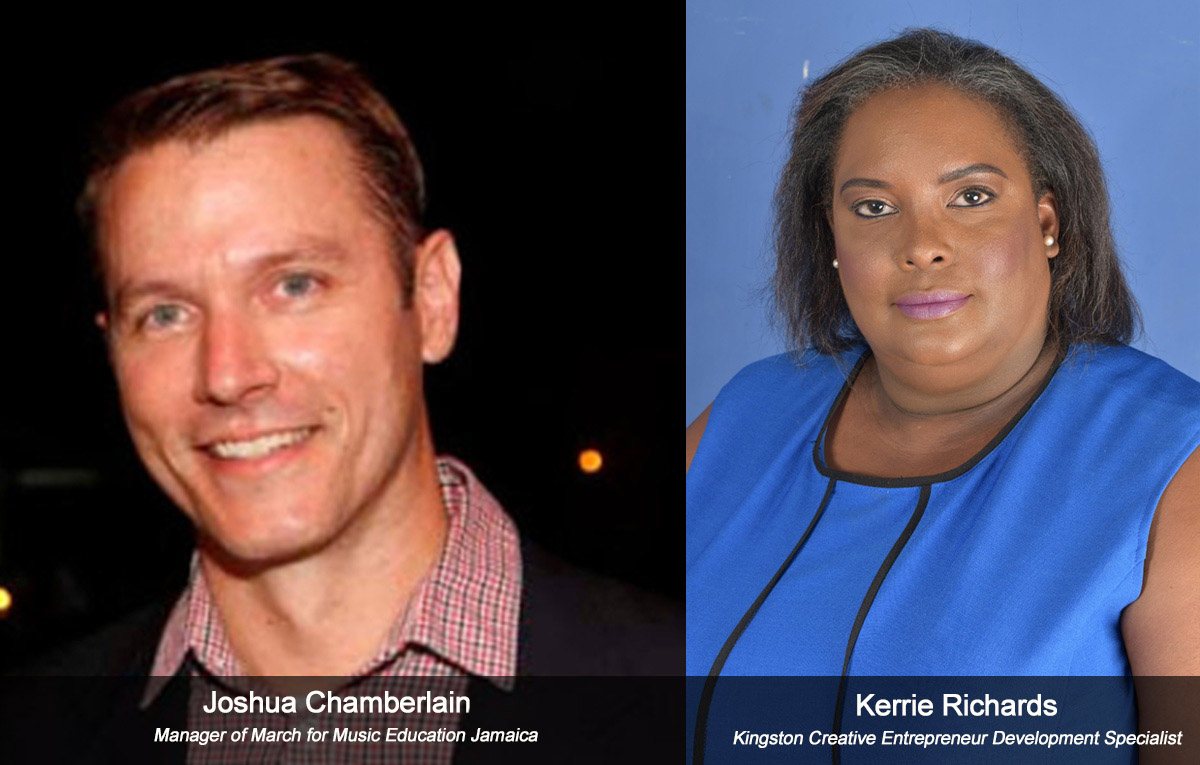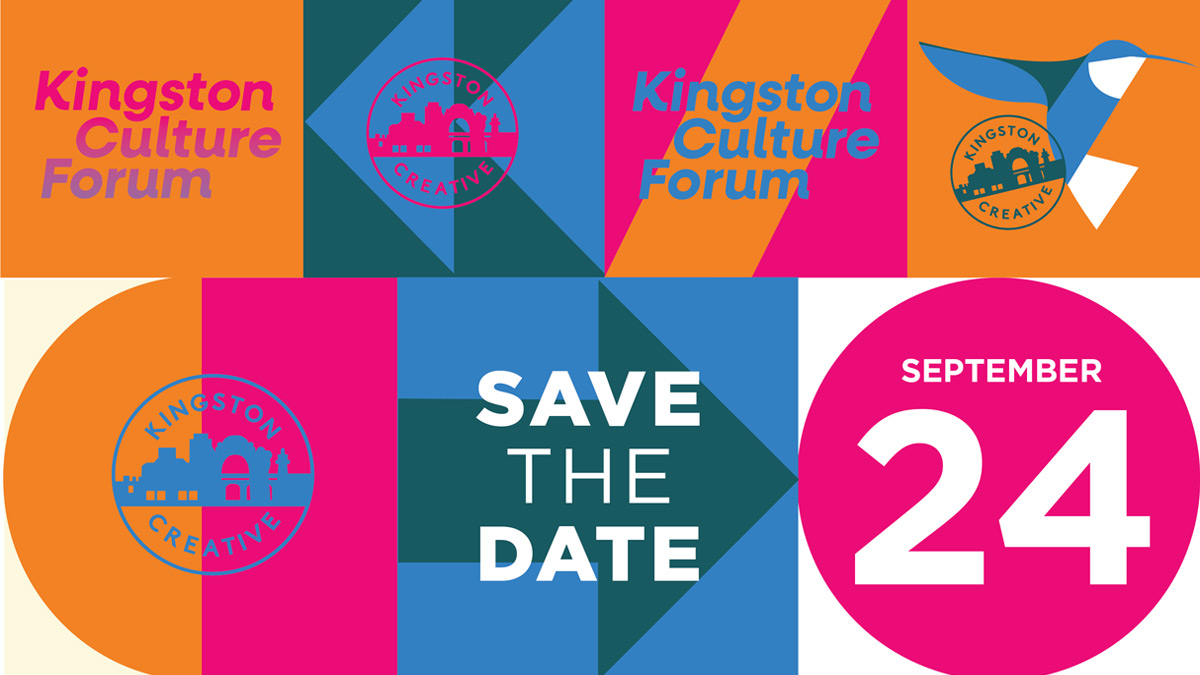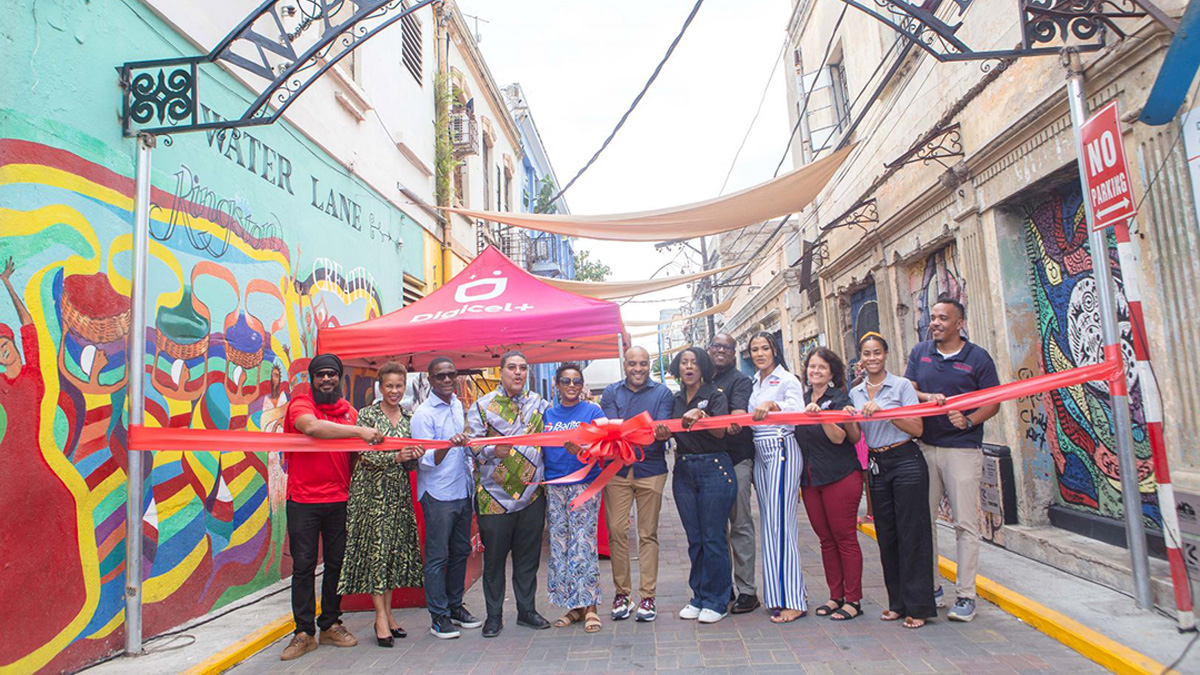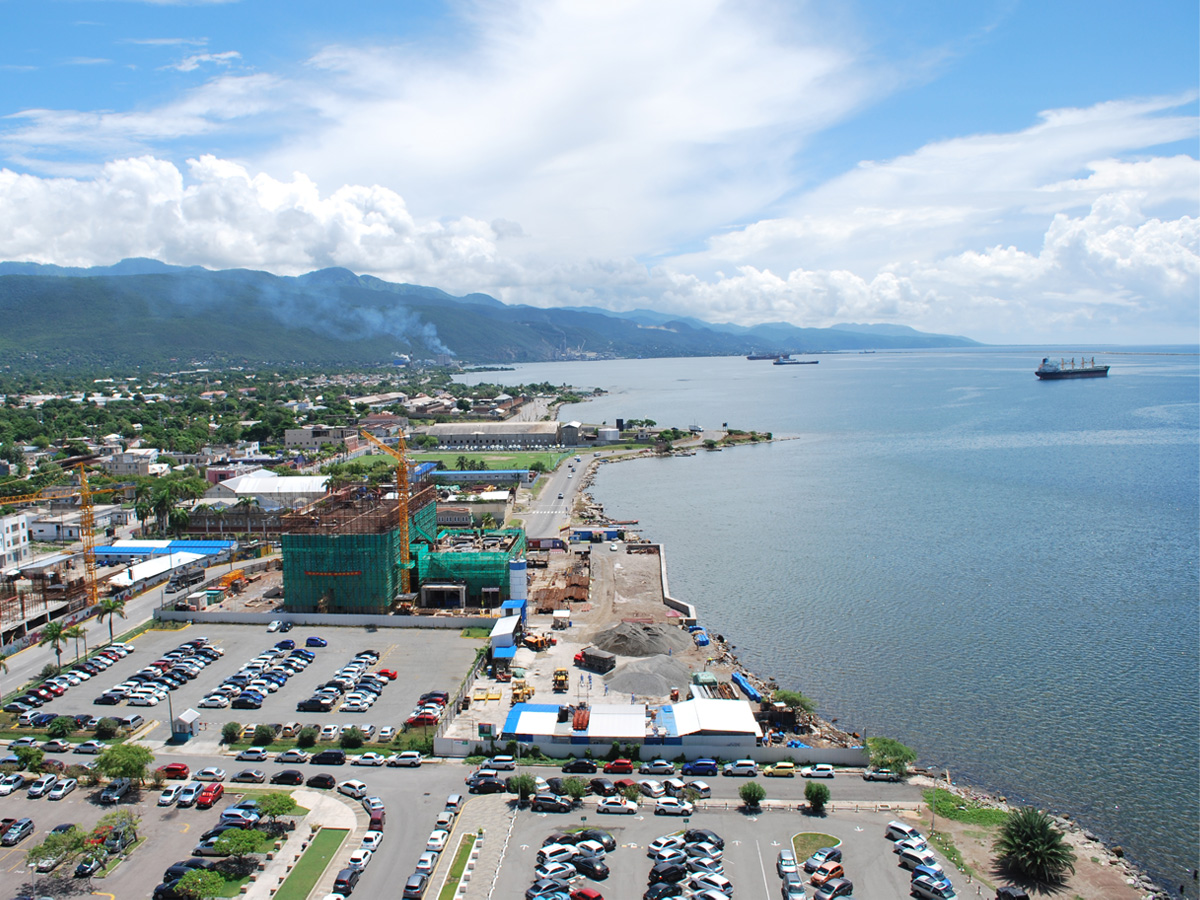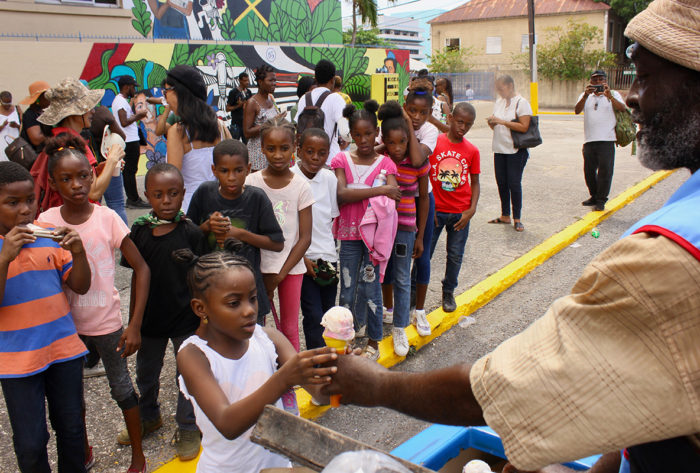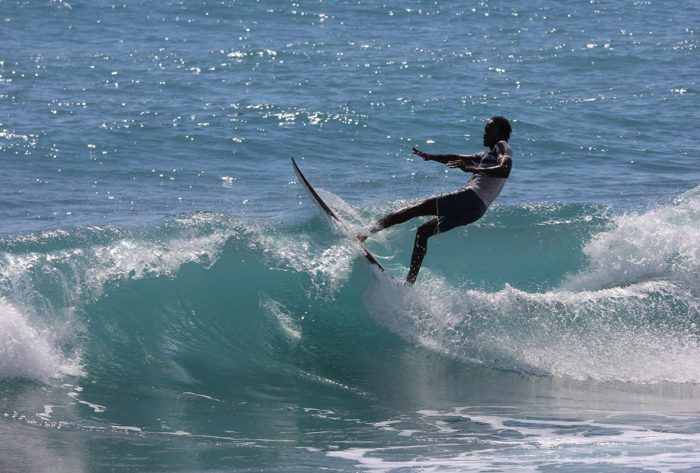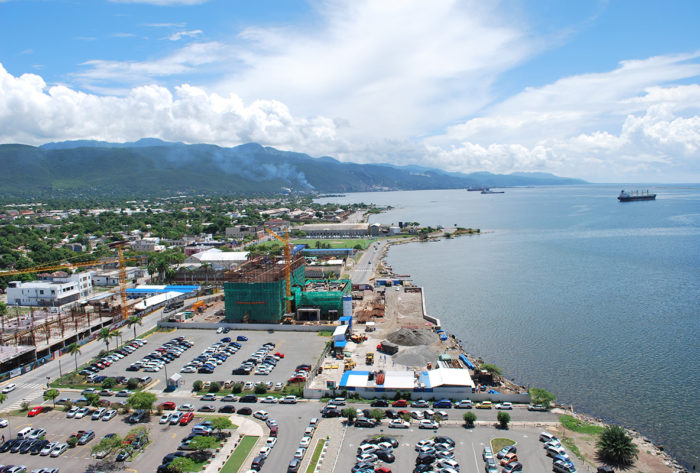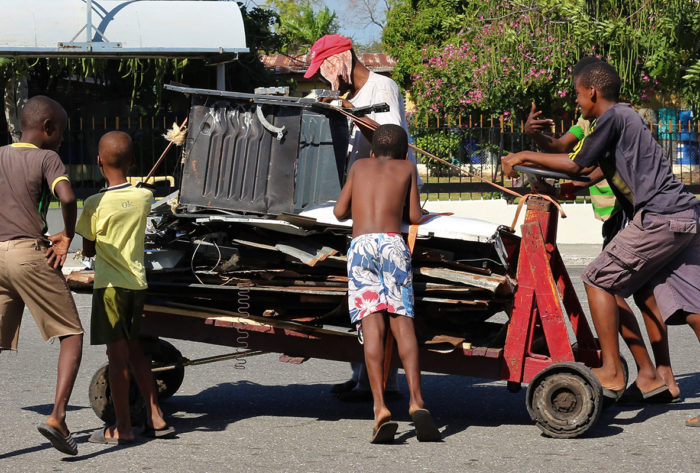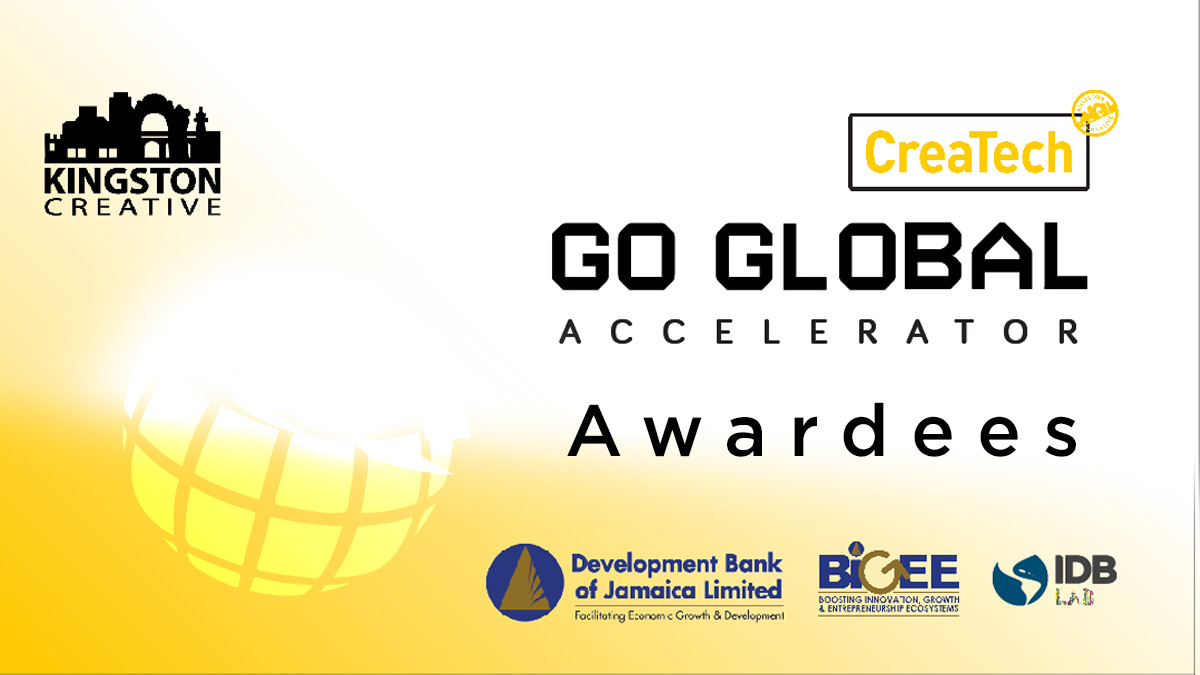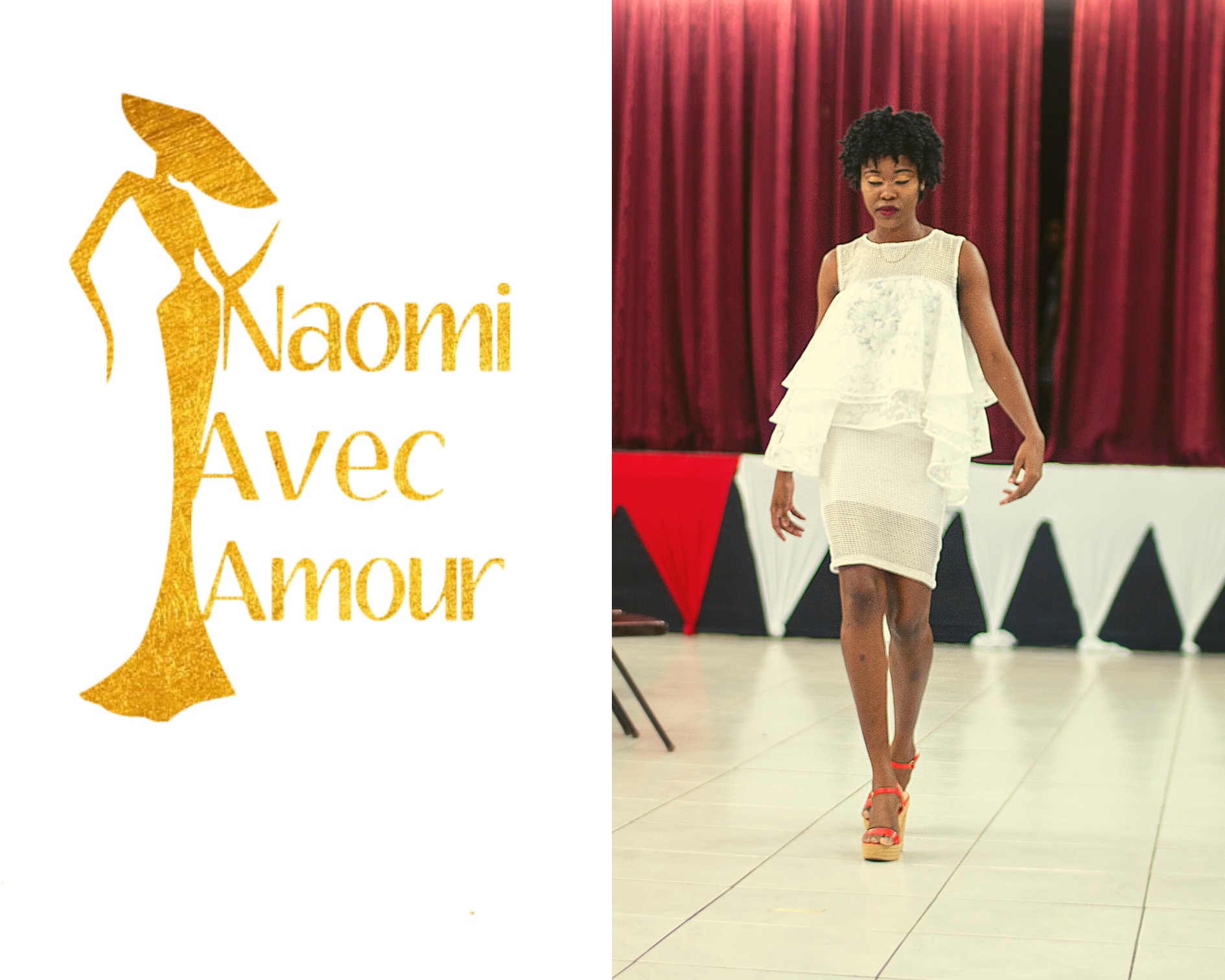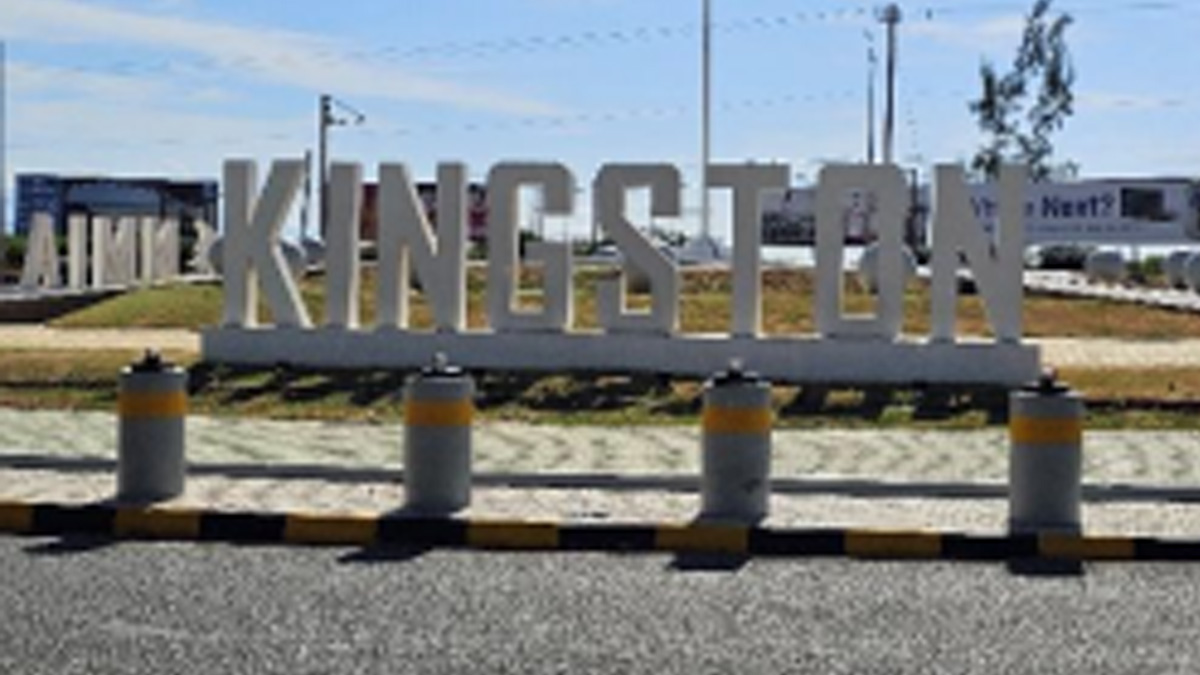Category: Blog_Post
All blog posts
Kingston Creative Incubator Mentors 12 New Startups
Kingston Creative today announced that 114 applicants applied to be a part of the second Creative Hub Incubator Cohort . Since 2021, Kingston Creative has partnered with the InterAmerican Development Bank’s IDB Lab and the Development Bank of Jamaica’s BIGEE programme, to help early-stage Orange Economy startups drive business growth. The incubator provides this through mentoring, provision of working space and scaling activities.
Kingston Creative helps startups in the Cultural and Creative Industries to connect and network, with a focus on generating internal traction. Over the past two years, the Creative Hub has incubated a total of 12 startups and facilitated coworking space, pitch nights, meetups, hackathons, B2B meetings and technology adoption for many creative entrepreneurs.
For the second cohort, twelve (12) new Creative Startups were selected by a panel of creatives and entrepreneurs on August 2, 2022. The selection panel consisted of Joshua Chamberlain (Manager, March for Music Education Jamaica),Maria Hitchins (Lecturer and Founder of Dancers of Jamaica), Kerrie Richards (Kingston Creative Entrepreneur Development Specialist) and Karen Hutchinson (CREATECH Programme Manager).
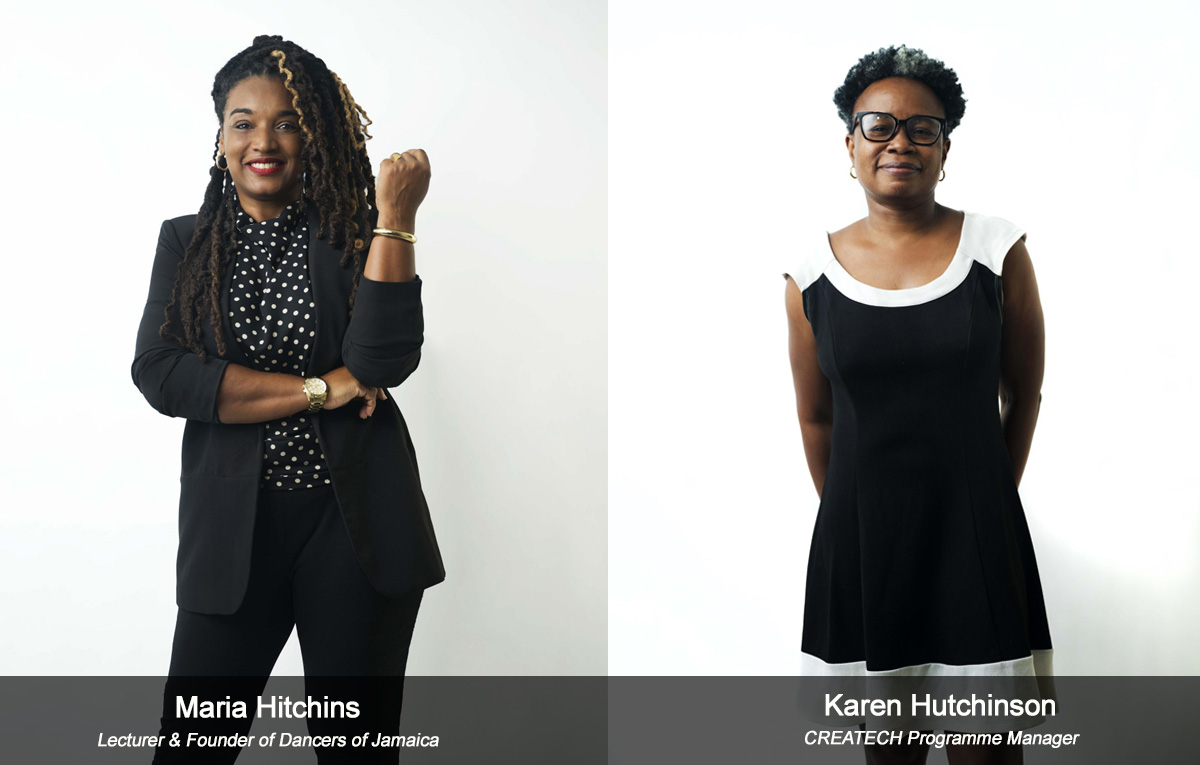
The participants in the 2022 Creative Hub Incubator are Tamika Nelson, Lilieth Case, Jordanne Alveranga, Jenelle Samuels, Lesli-Ann Belnavis-Elliott, Shavaun Reid, Alexandra Stultz, Jonathan Roberts, Kay Smith and Debra McKessey.
During the course of the program, the incubatees will receive mentorship, attend workshops designed to enrich business skills and gain membership at the Kingston Creative Hub (located at 107 Harbour Street in Downtown Kingston) which gives them access to a hot desk, meeting rooms, and a shared office.
They will also have the opportunity to apply for travel grants, pitch for startup funding and be paired with potential investors through JAMPRO supported B2B meetings. Finally, they have the chance to network with other creative entrepreneurs and grow with a community of like-minded individuals.
Kerrie Richards, Kingston Creative Entrepreneur Development Specialist commented, “What we will do over the next few months will be life changing. The creatives will be given the tools, training and environment that will create a solid structure for growth. It will be an exciting time and I look forward to supporting them.“
Christopher Brown, Project Manager, DBJ’s Boosting Innovation Growth and Entrepreneurship Ecosystems (BIGEE) stated, “The DBJ, through BIGEE, is delighted to partner with Kingston Creative in facilitating the growth and development of Jamaica’s Creatives. We are committed to unlocking the entrepreneurship side of our creatives to maximise the value and sustainability of their talent.”
—
Kingston Creative is investing in “People and Place”; developing strong Jamaican creative entrepreneurs and building a vibrant Art District in Downtown Kingston.
Kingston Creative Introduces New Digital Commissions For Local Artists
 In light of the impact on creative people and businesses from the COVID-19 outbreak, Kingston Creative is introducing a new pot of funds for virtual arts activities, called Digital Commissions. Understanding that it is critical to keep creatives earning and visible during this time, the local arts NGO is allocating $2,700,000 to new commissions that creatives in Jamaica can apply until – May 31, 2020 by contacting [email protected].
There are four tiers of Digital Commissions:
1. The Virtual Artwalk
Artists and Artisans can record videos which will be aired on Last Sundays on Kingston Creative’s IGTV channel and be available on Kingston Creative’s YouTube Channel afterwards. The goal is to keep artists earning from virtual performances; to maintain artists visibility while promoting their contact details and delivery options that they use to get the goods to the customers and of finally to allow the audience to experience and enjoy the arts and creative products during this period. Artists and Artisans will be paid $5000 – $15,000 for each segment depending on the length of the segment. Up to 50 artists will be selected each month.
2. Creative Presentations
Creatives can pre-record or livestream a webinar or workshop for airing on their own social media platforms and/or the Kingston Creative Social media channels. This can take the form of an artist talk, a “how-to” workshop, a book reading, or studio tour. Recommended platforms are Zoom, Facebook Live or IGTV. The artist must interact by answering questions posted by viewers in the comments section for 15 minutes. Kingston Creative will provide training and support and pay a fee of $5,000 – $15,000 to each selected artist. Up to 10 artists per month will be selected.
3. Artist Articles
We are looking for a series of written features (~2000 word minimum), accompanied by photographs or video that give insight into a day in the life or career path of a Jamaican creative (artist/writer/filmmaker/fashion designer etc.). These will be selected, posted on social media and published on the Kingston Creative Website and Blog. Each selected artist will be paid $10,000 – 20,000 for the feature. Up to five artists will be selected each month.
4. Open Commissions
Pitch Kingston Creative an idea for an innovative online event, discussion, performance or exhibition – anything that can take place or be displayed online. These are open commissions, so bring your best ideas, and say how much you think it will cost. Applications from collectives or industry associations are welcomed.
Kingston Creative is committed to ensuring the continuity and viability of creative entrepreneurs during this challenging time. They will be continuing to implement the mural commissions and contracts that were in train for visual artists to create street art in Downtown Kingston, provided that the necessary social distancing and Ministry of Health orders can be properly observed.
The nonprofit organisation is also polling the creative community to identify the individuals at risk, needs, recommendations and strategies that people are using to cope or pivot their businesses. They then share this information and suggestions made by the creative community with decision-makers regularly. To participate in the survey, use the link: https://www.surveymonkey.com/r/SCK365F
Last but not least, Kingston Creative encourages open communication between creative practitioners at this time. Through a weekly online chat about resilience in the arts sector, they are creating a collaborative space to discuss solutions. This happens on Thursdays at 10:00 am and people can direct message Kingston Creative on any social media platform to receive the Zoom link to join in. People can also share their views and suggestions via Twitter by posting comments and questions using the hashtag: #COVID19JACCI.
View Linkedin Post
In light of the impact on creative people and businesses from the COVID-19 outbreak, Kingston Creative is introducing a new pot of funds for virtual arts activities, called Digital Commissions. Understanding that it is critical to keep creatives earning and visible during this time, the local arts NGO is allocating $2,700,000 to new commissions that creatives in Jamaica can apply until – May 31, 2020 by contacting [email protected].
There are four tiers of Digital Commissions:
1. The Virtual Artwalk
Artists and Artisans can record videos which will be aired on Last Sundays on Kingston Creative’s IGTV channel and be available on Kingston Creative’s YouTube Channel afterwards. The goal is to keep artists earning from virtual performances; to maintain artists visibility while promoting their contact details and delivery options that they use to get the goods to the customers and of finally to allow the audience to experience and enjoy the arts and creative products during this period. Artists and Artisans will be paid $5000 – $15,000 for each segment depending on the length of the segment. Up to 50 artists will be selected each month.
2. Creative Presentations
Creatives can pre-record or livestream a webinar or workshop for airing on their own social media platforms and/or the Kingston Creative Social media channels. This can take the form of an artist talk, a “how-to” workshop, a book reading, or studio tour. Recommended platforms are Zoom, Facebook Live or IGTV. The artist must interact by answering questions posted by viewers in the comments section for 15 minutes. Kingston Creative will provide training and support and pay a fee of $5,000 – $15,000 to each selected artist. Up to 10 artists per month will be selected.
3. Artist Articles
We are looking for a series of written features (~2000 word minimum), accompanied by photographs or video that give insight into a day in the life or career path of a Jamaican creative (artist/writer/filmmaker/fashion designer etc.). These will be selected, posted on social media and published on the Kingston Creative Website and Blog. Each selected artist will be paid $10,000 – 20,000 for the feature. Up to five artists will be selected each month.
4. Open Commissions
Pitch Kingston Creative an idea for an innovative online event, discussion, performance or exhibition – anything that can take place or be displayed online. These are open commissions, so bring your best ideas, and say how much you think it will cost. Applications from collectives or industry associations are welcomed.
Kingston Creative is committed to ensuring the continuity and viability of creative entrepreneurs during this challenging time. They will be continuing to implement the mural commissions and contracts that were in train for visual artists to create street art in Downtown Kingston, provided that the necessary social distancing and Ministry of Health orders can be properly observed.
The nonprofit organisation is also polling the creative community to identify the individuals at risk, needs, recommendations and strategies that people are using to cope or pivot their businesses. They then share this information and suggestions made by the creative community with decision-makers regularly. To participate in the survey, use the link: https://www.surveymonkey.com/r/SCK365F
Last but not least, Kingston Creative encourages open communication between creative practitioners at this time. Through a weekly online chat about resilience in the arts sector, they are creating a collaborative space to discuss solutions. This happens on Thursdays at 10:00 am and people can direct message Kingston Creative on any social media platform to receive the Zoom link to join in. People can also share their views and suggestions via Twitter by posting comments and questions using the hashtag: #COVID19JACCI.
View Linkedin Post
Kingston Creative Launches New Travel Programme for Creatives
Kingston Creative, in partnership with the Inter-American Development Bank Lab (IDB Lab) and the Development Bank of Jamaica (DBJ) is introducing a Travel Grant Programme which will facilitate visits to overseas markets by six creative entrepreneurs between August 2022 – December 2023. This year, three Jamaican creatives will participate in creative fora and festivals in Mexico, Haiti & Curacao respectively.
The artists participating in this year’s Travel Grant programme are Kenardo Ellis (musician), Anthony Smith (visual artist), and Matthew McCarthy (visual artist). They will be participating in the UNESCO Creative Cities Forum in Querétaro, Mexico, the Kaya Kaya Festival in Curaçao, and the Festi Graffiti Festival in Haiti respectively.
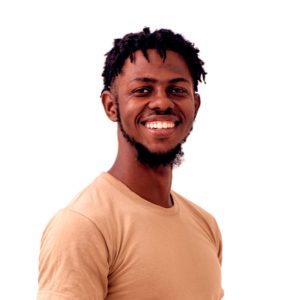
Anthony Smith (Muralist)
“Travel is essential for Caribbean artists,” stated Andrea Dempster Chung, Executive Director of Kingston Creative. “Not only does it give inspiration and foster collaboration, it allows artists to reach new customers. We have a relatively small market in Jamaica for creative services and it is important that our artists have the opportunity to showcase their talent, export their artwork and develop strong business connections in other regions of the world. This is a very exciting programme and a big part of what we are doing is giving creatives access to income-earning opportunities they would not usually get.”
Kenardo ‘Ken’ Ellis, reggae musician and Travel Grant participant said, “This is a great time opportunity for creatives looking to expand their reach. This integration will bring forth more diverse opportunities to grow our creative culture and foster collective partnership among creatives from various parts of the world. I am more than grateful and honoured to be a part of this initiative.”
“The travel grant makes perfect sense for an emerging creative scene like Jamaica,” said Matthew McCarthy, “Kingston Creative understood that people want to connect and there are many opportunities to do so if things are coordinated well. I’m really grateful for that aspect. The grant helps to make these connections more seamless.”
“I am humbled to be part of Kingston Creative’s first travel grant.” Anthony Smith, Travel Grant participant stated, “ It’s an awesome thing to see what a collaboration of aligned values and interests can do for the creative economy at the national level. Great things are in store.”
Kingston Creative to host inaugural “Kingston Culture Forum” on Friday September 24, 2021
Kingston Creative will launch an annual summit this month, the Kingston Culture Forum. The Kingston Culture Forum is a conference convening cultural and creative industry stakeholders in the public, private, academic and social sectors. The theme for the event will be “Downtown Kingston: creative economy, placemaking and sustainable urban development”.
The first staging, slated for September 24th of this year, aims to attract a wide audience with participation from local creatives, as well as regional and global participants. The Kingston Culture Forum will focus on centering cultural and creative dialogue on Downtown Kingston, building confidence in using technology for the sustainable preservation of cultural heritage and promotion of creative industries and to also advocate for a data-driven approach to cultural and creative industry policymaking.
The Kingston Creative Culture Forum programme will include the following components:
- Museums, and heritage institutions and their role in preserving cultural memory in the digital age – Moderated by – Dr. Sonjah Stanley Niaah, Institute Caribbean Studies
- Creative Placemaking and Urban Regeneration in Cultural and Creative Cities – Moderator – Moderated by – Ms. Maxine Fisher-Casserly, Urban Development Corporation
- Policies for growing cultural and creative industries through the Festival/Experience economy – Moderated by – Mr. Harold Davis, Jamaica Business Development Corporation
- Capacity building in communities: promoting creative industry and preserving heritage in at-risk communities – Moderated by – Ms. Rhian Holder, Jamaica Social Investment Fund
- Creative Partnership & Opportunity Pitch – Moderated by – Mr. Kimalea Campbell, Executive Director, Weekly Projects
- ‘CreaTech’: best practices in Creativity and Technology amongst creatives – Moderator – Dr. Isis Semaj-Hall, Pree Lit Magazine
Additionally, the event will feature a performance by Sevana and an extensive list of esteemed guest speakers including:
- Jherane Patmore, Rebel Women Lit
- Joshua Chamberlain, The Alpha Institute
- Renee Robinson, JAMPRO
- Michael Holgate, The Ashe Company
- Kevin Jackson, Jamaican Animation Nation Network
- Dr. Shani Roper, University of the West Indies Museum
- Justine Henzell, Calabash Literary Festival
- Howard McIntosh, Economic Advisory Board
- Charmaine Brimm, Planning Institute of Jamaica
- JLL, Music Producer
- O’Neil Lawrence, National Gallery of Jamaica
More participants will be announced. To register and for more information please visit – bit.ly/kingstoncultureforumregistration
Given the importance of the cultural and creative industries to the vitality of Jamaica and the region, Kingston Creative wants to address the global challenges, and consider the role that technology, enabled by public-private-third sector partnerships, will play in sustainable development through preserving cultural heritage and promoting the creative industry.
Kingston Creative Virtual Artwalk
- Jamaica Poetry Society – Poetry Corner featuring the poets: Wise Wurdz & Toots Hibbert, Ann Margaret Lim, Casey Garvey, Maverick, Peta-Gay Williams, Cherry Natural
- Iya Tear – Musician from Trench Town
- Christine Wright – Animated Storyteller
- Long Story Short – Modern Jamaican Storytelling with Charl Baker
- Ania Freer “Goat Curry Gallery” 2 documentary films on Alexander ‘Bamboo King’ Dempster (b.1955), Annotto Bay, St. Mary, and Albert ‘St John’ Phipps (b.1958), Port Antonio, Portland
- Majah – Dub Poetry Performance
- Rebel Women Lit – Virtual Book Club presents Quaren-Reads
- Ozoune and Pon Fyah – Jazz Band
- Tahelia Taylor – Experimental Poetry
Kingston Creative is a non-profit organization that believes in using creativity and culture to empower creatives and transform the city. They believe that the cultural and creative industries can be a catalyst for national development and are developing an Art District and Creative Hub in Downtown Kingston, Jamaica. Kingston Creative is developing an Art District and Creative Hub in what they call the creative capital of the Caribbean, Downtown Kingston, Jamaica in partnership with “First 50” Sponsors. You can follow Kingston Creative on social media Instagram, Facebook and on Twitter or visit the website for more info or to get involved. <style>#hero {background:black;height: 400px !important;}.single .hero-fullwidth .title-service h2 {color: white !important;}.article-img{display:none}#widget-area {display:none}.col-lg-8{width:100%} p{font-size:16px !important}</style>
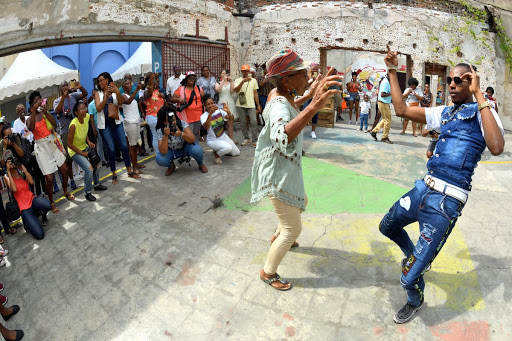
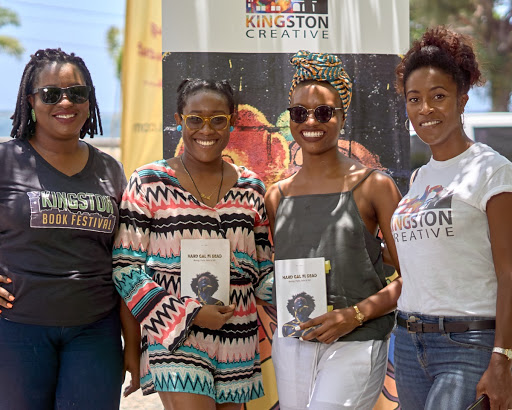

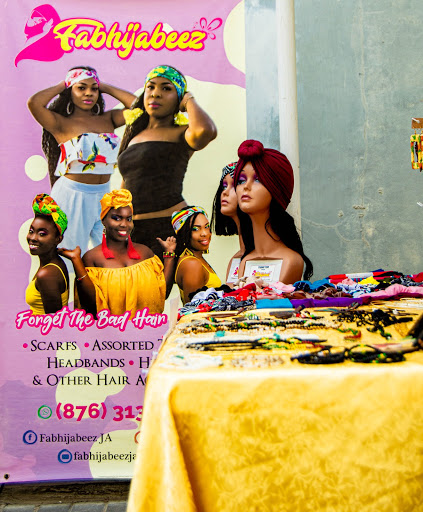
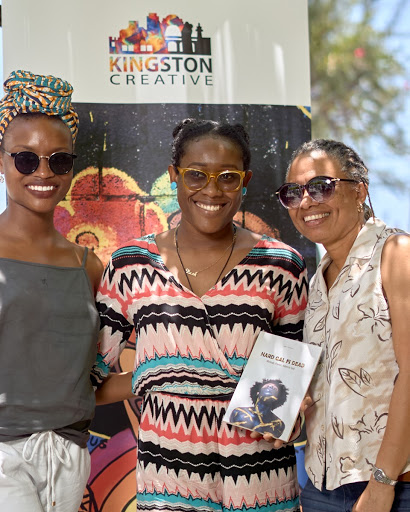


Kingston Creative: A Legacy of Transformation & Impact
Kingston Creative: A Legacy of Transformation & Impact
Kingston Creative, a Jamaican arts non-governmental organization (NGO), has been a staunch advocate for the country’s artists, creatives, and cultural practitioners. Over the past eight years, the organization has spearheaded efforts to transform Downtown Kingston into a world-class Art District, serving as a hub for the arts, innovation, and the growth of the creative economy.
Renowned globally as a cultural superpower, Jamaica boasts an abundance of innate talent. Kingston Creative’s mission is to harness this talent and convert it into sustainable social and economic development, benefitting creatives and the country at large. Their strategy focuses on fostering partnerships and cultivating a thriving ecosystem where creative entrepreneurs and their businesses can flourish.
Through intentional action and a collaborative approach, Kingston Creative is paving the way for a vibrant and prosperous future for young creatives in Jamaica. As Kingston Creative celebrates its eight year anniversary in February 2025, from global collaborations to award-winning projects, here are eight standout moments in the organization’s journey.
#1 The Artwalk Festival (2018) ~ Public Arts Festival in Downtown Kingston
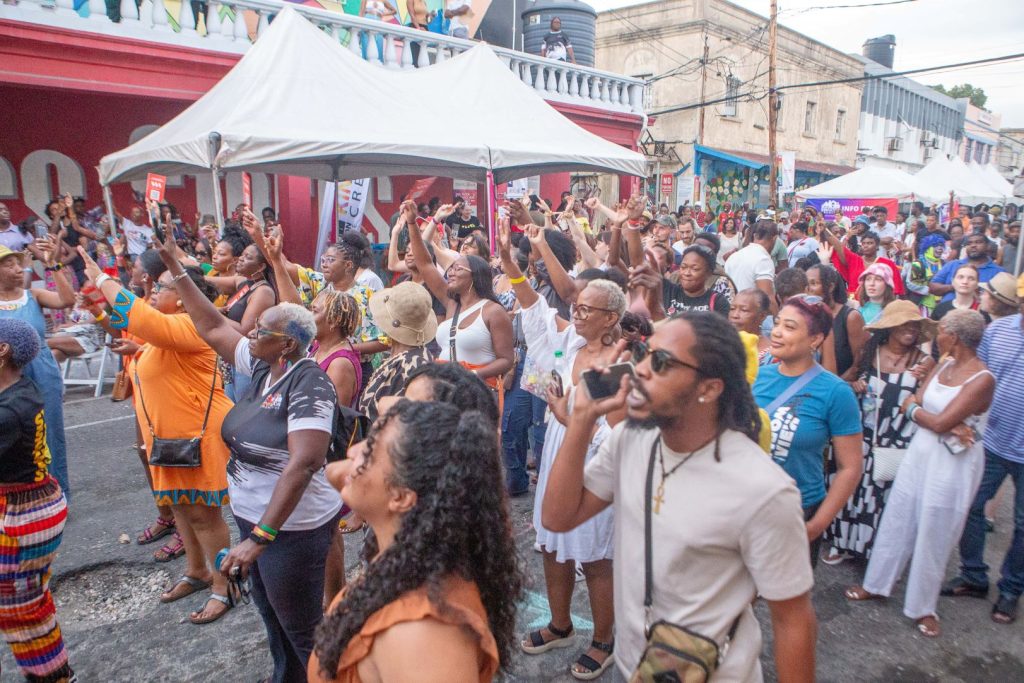
Patrons at the Kingston Creative Artwalk Festival Photo credit: Kingston Creative
Conceptualised as a free walk from the street art hub at Water Lane to various cultural spaces across Downtown Kingston, the monthly Artwalk Festival was launched in April 2018 and this event has become a cornerstone of Kingston’s cultural landscape. Over the years, Kingston Creative has collaborated with numerous artists and arts institutions on the festival, including the National Gallery of Jamaica, the National museum, Simon Bolivar centre, CreativSpace Art Gallery, Liberty Hall, the Jamaica Conference Centre and more. The festival has attracted thousands of visitors to Downtown Kingston and provided a platform for artists, musicians, and performers to showcase their talents. Over the 81 editions, artisans and performing artists have been able to earn significant income from the sales of their creative products and services. The main impact is the reduction in stigma associated with Downtown Kingston. It is now being viewed as a viable venue for events and night life.
#2 Paint the City (2018) ~ Developing an Art District
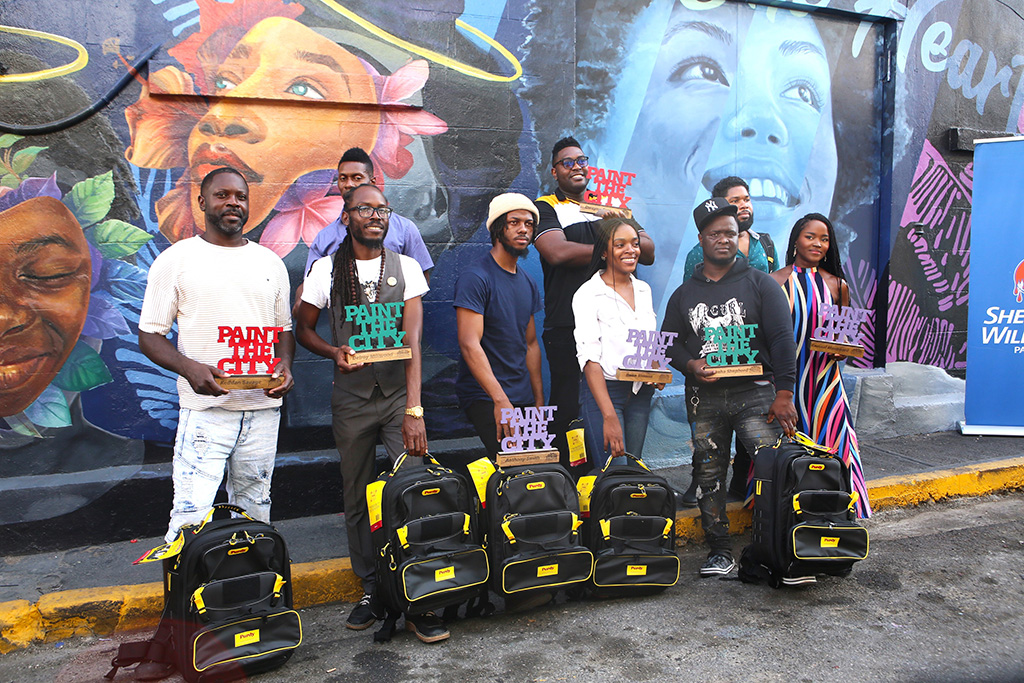
Jamaican Artists in Water Lane L-R Keddan Savage, Rupert Tomlinson, Delroy Millwood, Anthony Taoszen Smith, Dwayne Grant, Deon Simone, Nakeha Shepherd, Kamaal Manboard and Johnell Chambers. Photo credit: Kingston Creative
The street art gallery referred to colloquially as just ‘the Artwalk’ started in November 2018 when acclaimed Jamaican artist Bernard Hoyes painted his mural “Celebration” on the back of the Swiss Stores building in Water Lane. Over the years Kingston Creative has installed over 116 murals across Jamaica, from Black River to Downtown Kingston in partnership with the Tourism Enhancement Fund, Sherwin Williams and other partners. This initiative has brought together Jamaican artists and community members and catalyzed new income-earning opportunities for visual artists across the island. From a neglected back alley, Kingston now has an Art District. The rising popularity of murals has resulted in the development of a viable industry for artists who now are in demand to produce murals all over the country. One of the biggest impacts is the new visitor traffic to Water Lane, as tourists arrive in groups to see stunning murals that celebrate our rich cultural heritage.
#3 Kingston Creative Coworking Space (2020) ~ A Home For Creatives

The interior of the Kingston Creative Coworking Space, mural by artist Rebecca Levy. Photo credit: Kingston Creative
The Kingston Creative Coworking Space is a multipurpose arts venue located in Kingston’s historic Downtown Kingston business district at 107 Harbour Street, the intersection of Church Street and Water Lane. Founded in 2020 with the support of the Development Bank of Jamaica and the Tourism Enhancement Fund, it houses several creative businesses and serves as a home for a diverse community of artists and creatives.
An MTV Tiny Desk Concert, featuring recording artist Sevana, was filmed at the location and broadcast across the world. The space also boasts a podcast studio with lighting and recording equipment for rent. Kingston Creative offers wall space to feature rotating exhibitions by artists and also allocates free storefront space for artisans and makers. In addition, the space prioritizes nurturing the development of other arts organizations by offering its boardroom meeting space free of cost to various groups.
Over the years, this hub has played a crucial role in fostering innovation within Jamaica’s creative sector and has been home to hackathons, pitch competitions, incubators and accelerator programmes. The main impact of the coworking space is its function as a venue for creative events and as a content creation space which delivers across core sectors and catalyses innovation and growth.
#4 CREATECH (2021) ~ A 3-year Technology Collaboration with IDB Lab
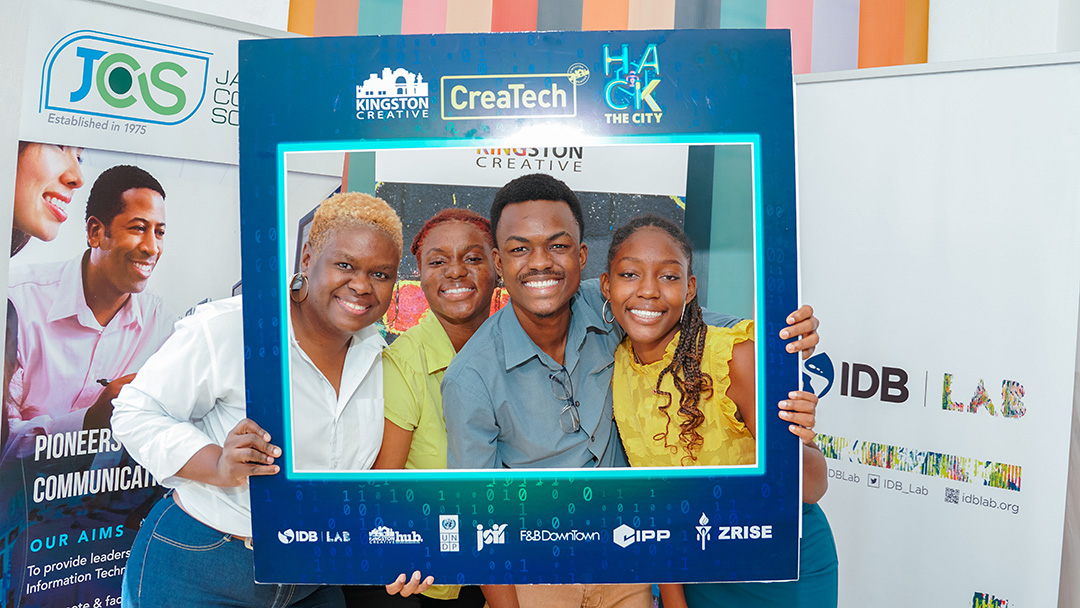
The interior of the Kingston Creative Coworking Space, mural by artist Rebecca Levy. Photo credit: Kingston Creative
Kingston Creative partnered with the Inter-American Development Bank’s IDB Lab on a groundbreaking project to develop the local Creative ecosystem in Jamaica, thereby fostering creative entrepreneurship and innovation in the region. Winner of the IDB Excellence in Project Execution Award in 2023, the CREATECH programme benefitted over 1,500 creatives over three years, investing over $1.3 million USD in the sector. Createch equipped creative entrepreneurs with the platforms, business skills, funding, travel opportunities and mentorship needed to grow their businesses and contribute to Jamaica’s creative economy. The impact of Createch was a renewed awareness of the potential of MSME entrepreneurs within the cultural and creative industries to make a positive impact on the overall economy.
#5 Launched 2 New Digital Platforms for Creatives (2022)

Digital Platforms, Caribbean Creative network and the Kulcha Connect App . Photo credit: Kingston Creative
Kingston Creative has taken a major step toward empowering regional artists with the launch of the Caribbean Creative Network, a new digital platform of over 500 artists, aimed at fostering cross-border collaboration in the creative sector. The platform is accessible at Caribbean Creative Network, and seeks to bridge gaps in the visibility of artists across the Caribbean.
In addition, the organization has introduced the Kulcha Connect App (Kulcha Connect), an e-commerce platform designed to streamline cross-border payments for Jamaican artists, promote cultural tourism and increase the sales of cultural products and services. The app not only facilitates financial transactions but also showcases events by local creatives and offers guided tours of Downtown Kingston, further promoting the city’s rich cultural heritage.
#6 World’s Best Creative Destination (2023) ~ Global Tourism Award
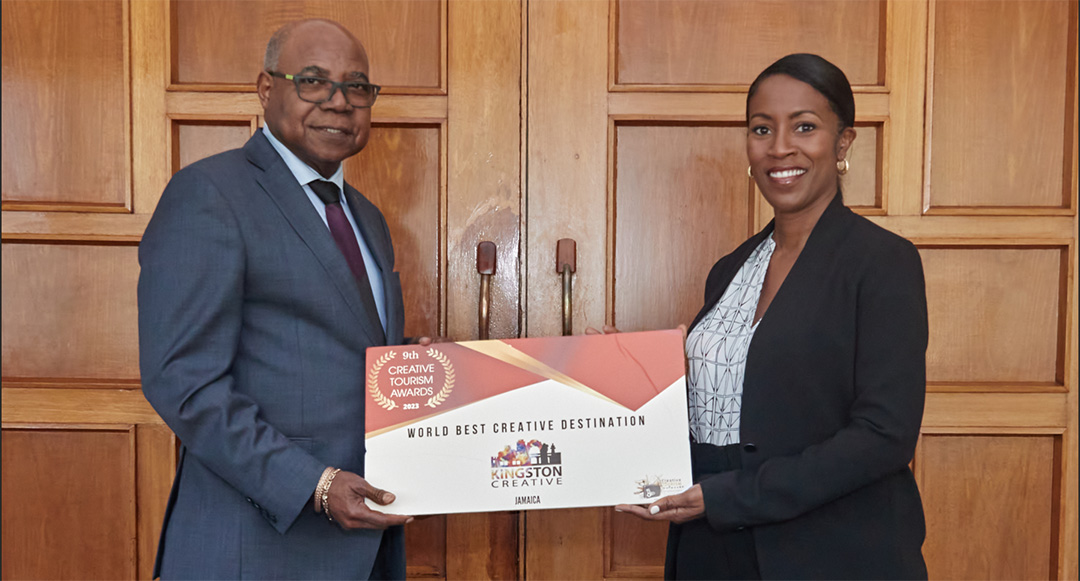
Digital Platforms, Caribbean Creative network and the Kulcha Connect App . Photo credit: Kingston Creative
Downtown Kingston’s Art District earned global recognition in 2023, securing the title of “World’s Best Creative Destination”. The city was selected from a competitive field of 152 applications spanning 28 countries. The winning application was presented to Kingston Creative, highlighting the city’s dynamic arts and cultural scene. The prestigious award was officially handed over to Tourism Minister Edmund Bartlett by Caroline Couret, director of the Creative Tourism Network, on behalf of the international selection committee during a ceremony in Berlin, Germany.
#7 Global Climate Change Project, ‘A Feral Commons’ (2022)

Mayor of Kingston Andrew Swaby, Artist Camille Chedda and project partners from the KSAMC, UDC, Gore Foundation, Digicel Foundation, iPrint Group and the Global Cultural Districts Network (GCDN) in the Climate Change Art Park. Photo credit: Kingston Creative
Kingston Creative was a partner in “A Feral Commons”, a climate change arts initiative that leverages art, culture, and community engagement to address environmental challenges while fostering artists’ international collaboration. Through partnerships with organizations like the Global Cultural Districts Network and Alserkal Initiatives, the project has facilitated artistic exchanges between Kingston, Jamaica, Johannesburg, South Africa, and Dubai, UAE, creating opportunities for cross-cultural dialogue and creative innovation. These exchanges have not only expanded the global presence of Jamaican artists like Camille Chedda, but have also catalyzed international funding opportunities and strengthened cultural diplomacy efforts. Through programmes like this, Kingston Creative has sent over 10 artists abroad on travel grants to the UK, Germany, Haiti, Mexico, USA, Curacao, Colombia.
#8 Adopt-A-Block Crowdfunding Initiative (2024)
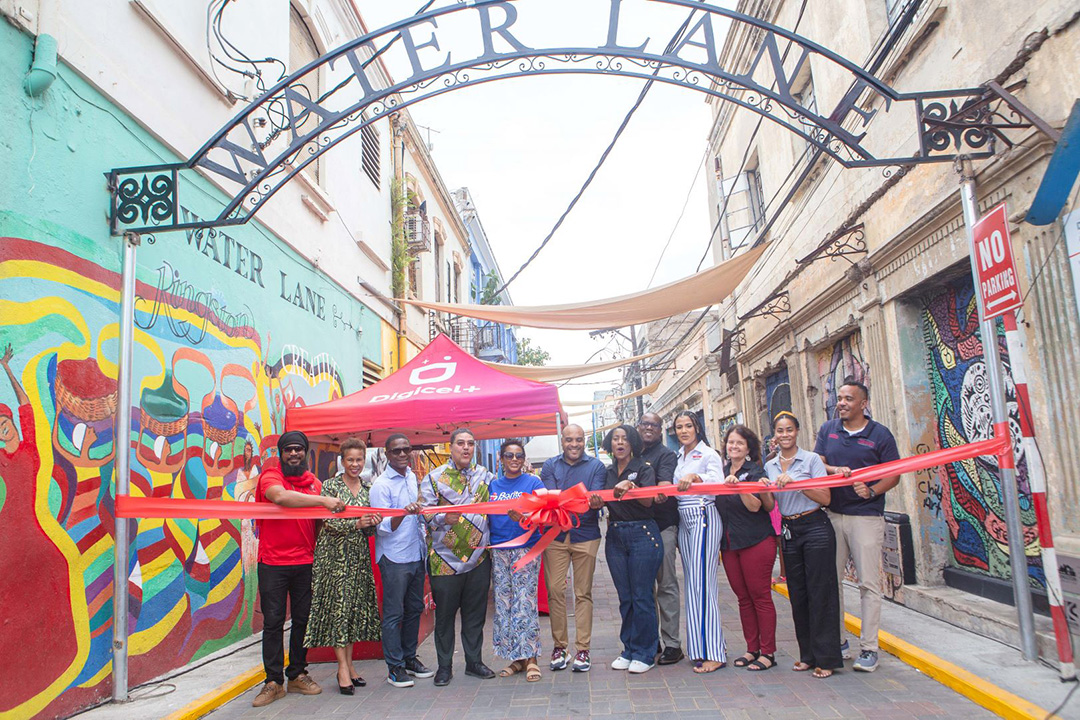
Project partners in Adopt A Block stand in Water Lane, including Digicel Foundation, Bank of Jamaica, PwC, Ministry of Culture, Barita Foundation, KSAMC, National Bakery Foundation, Gore Foundation. Photo credit: Kingston Creative
The Adopt A Block initiative is a ground-up crowdfunding initiative designed to reshape urban spaces in Kingston by enrolling public and private sector entities and the general public to contribute to developing a block of Downtown. The project is driven by partners like Barita, Digicel, PwC, Bank of Jamaica, VM Group, National Bakery, and Gore, to add essential infrastructure such as shade, solar lighting, recycling, seating, signage and security—elevating the city’s reputation as a global cultural destination and having a powerful economic impact.
Each of these eight milestones underscores Kingston Creative’s commitment to empowering artists, revitalizing urban spaces, and expanding Jamaica’s creative economy. By championing the cultural and creative industries, the organization is not only fostering local talent but also positioning Jamaica as a global leader in the sector. Looking ahead, Kingston Creative remains focused on its mission: leveraging art and culture as catalysts for sustainable economic growth and social transformation not only in the capital city of Kingston, but across the island.
Kingston Creative is a non-profit charity organization, funded by grants and donations. To support the work of Kingston Creative, please visit www.kingstoncreative.org/donate. If you are interested in supporting the artists and the transformation of Downtown, you can donate via PayPal, through AFJ or directly to Kingston Creative. On Pay Pal you can set up a monthly recurring or one-time payment to support the cause. American Friends of Jamaica is a registered 501(c) 3 tax exempt organisation in the USA and US residents can donate through them to receive a tax exemption. Jamaicans can also donate tax free directly to Kingston Creative as they are a registered charity organisation. For more information, please call (876) 546-6943 or email [email protected].
Kingston Creative’s Downtown Kingston Manifesto
Urban revitalization is on everyone’s radar as cities strive to remake blighted areas into economically productive and attractive spaces. The United Nations recently launched “SDG Cities” through UN Habitat; a 1000 city global initiative to unleash the potential of cities to accelerate sustainable development and improve quality of life for all. Cities generate 80% of the world’s economy, and countries cannot afford to have their city centres in a state of decay. Formerly the thriving commercial and cultural centre of Jamaica, “Uptown” flight left Downtown Kingston underinvested and surrounded by some of the most densely populated, politicized, high crime and poverty ridden communities in the country.
A Downtown Renaissance
After over half a century of neglect, what remains is an interesting mix of established businesses, creative people, communities with a global cultural brand and architectural assets ripe for renovation. The harbour, churches, theatres, museums, eateries, history, shops, and street art all make cultural tourism a viable strategy for Downtown Kingston’s renaissance. As UNESCO recognized with the Creative City of Music designation in 2015, this is the crucible where most of Jamaica’s music was birthed. With solid leadership and investment, the old city can become an attractive space for locals and visitors alike, creating jobs and opportunities with business clusters for both the consumption and production of creative goods and services.
The Kingston Creative tagline is “art for social and economic transformation” and it useful to explore what that means when put in practice. When the arts are used to revitalize a space, it is generally referred to as ‘creative placemaking’. This involves beautification, infrastructure improvement, as well as engaging communities in activating the space through festivals, live music, and events. Creative placemaking brings value to the city in diverse ways, such as artistic, educational, social, community, urban, environmental and economic value through cultural tourism and creative economy growth.
Avoiding the Dangers of Gentrification
The question is how the transformation of Downtown Kingston can be achieved without gentrification. Gentrification is generally regarded as an undesirable side-effect of urban renewal campaigns. It involves the marginalization and displacement of existing residents and communities, because of increases in property values. This affects longtime residents, grassroots economic ventures such as street vending, markets, corner shops and bars, informal and traditional manufacturing, cottage industries and even community events such as street dances. A lot of this happens passively, and sometimes even unintentionally, but in its extreme form, gentrification involves active “social cleansing,” whereby poor and marginalized individuals and communities are deliberately targeted and removed from the area to make way for more “desirable” inhabitants (Janoschka & Sequera).
One can see how the well-meaning efforts to “beautify” and regenerate Downtown Kingston, could lead to the exclusion and eviction of residents to the sole benefit of developers and property owners. The communities in danger of displacement are arguably the creators of the culture which is so critical to Jamaica’s identity and brand. To displace a community of potters that have lived in Rose Town for centuries, passing on knowledge and skills from generation to generation, would be disastrous. Disruption of networks of musicians in Trench Town could limit their ability to collaborate, innovate and create new genres of Jamaican music in the future. A street dance In Rae Town is a community affair, and it is not a stretch to say that in our fragile cultural ecosystem, largely unsupported by state structures, much of Jamaica’s cultural capital could be destroyed by gentrification of Downtown communities.
Social Justice & Partnership
There must be an element of social justice in any transformation process, and it has long been posited that the provision of affordable housing is the best way to prevent gentrification. We believe in a three-pronged approach grounded in strong public, private, and third-sector partnerships with coordination on matters of urban regeneration and creative economy growth. This partnership approach is key to achieving the balanced, inclusive development, that we seek in Downtown Kingston. Our partnership with the Jamaica Social Investment Fund, CB Facey Foundation, Fight for Peace, Boys Town and PIOJ’s Community Renewal Programme are designed to ensure grassroots level inclusion and anti-gentrification. Through the PIOJ, communities will soon be mapped to identify creative people and existing creative assets which must be centred in a ground up approach to development planning. The decision-making around culture and urban development must incorporate the interests of national and local government units, academia, grassroots movements, civic society, the residents of Downtown and the private sector.
Collaboration
Top-down and ground-up organizations and processes must work together to develop cities and simultaneously empower communities. Top-down plans generated by foreign consultants can be disconnected from community needs and destroy aspects of intangible heritage of which they are unaware. However there are limitations to a ground-up approach, as it can also be ineffective in dealing with macro-planning issues like zoning, transportation, historical preservation policies and the necessary civil and technological infrastructure needed for growth. We believe that that top-down policies need to meet the ground-up action. This will result in a collaborative process underpinned by community co-creation and the deliberate inclusion of diverse voices at the decision-making table.
Kingston Creative believes that creativity is the ultimate sustainable resource, and we align our initiatives with Vision 2030 and achievement of the UN’s Sustainable Development Goals. We seek to collaborate, bridging gaps and aligning initiatives as much as possible so that redundancies are reduced, and synergies are achieved. The creative agenda should be central at all levels of policy formulation, urban investment, and decision making. We want to see a future in which Downtown Kingston is thriving, and the cultural and creative industries, which is powered by ordinary Jamaican people, are allocated the appropriate respect, resources, structure, and support to be widely acknowledged as one of the top industries driving growth in Jamaica.
Andrea Dempster-Chung, Executive Director, Kingston Creative
Andrea is the cofounder of Kingston Creative, a nonprofit charity organisation seeking to transform Downtown Kingston through Art and Culture. She is a strategic business coach and has held senior management roles in the Government of Jamaica, Digicel and Gracekennedy and is also the founder of Bookophilia, a bookstore that promotes Caribbean literature. She has served on the boards of Jamaica Social Investment Fund (JSIF), The National Land Agency (NLA) and the Public Health Committee. She recently managed the Arts portfolio for the British Council where she developed strategy and implemented key projects in film, literature and visual art, in order to drive the creative economy in Jamaica. Andrea studied Art and Finance at the Sotheby’s School of Art in London, Finance at the Stanford School of Business in California and is certified in Project Management. She holds a Master of Science in Structural Engineering and a Bachelor of Science in Civil and Environmental Engineering from the Georgia Institute of Technology.
Send your questions and comments to: [email protected]
Literary Lounge Delights with Poetry, Art & Creativity
Literary Lounge Delights with Poetry, Art & Creativity
Kingston Creative hosted the monthly Creative Meetup entitled “Literary Lounge”, a memorable evening of connection, creativity, and cultural dialogue at the Kingston Creative Coworking Space in Downtown Kingston. The panel discussion featured Christine Randle-Wray, Director of UWI Press and former head of Ian Randle Publishers; Dr. Lisa Tomlinson, Head of the Department of Literatures in English at UWI Mona; Reneé Wallace, author and content creator known as @rensbookishspace and Annie Paul, Editor-in-Chief of PREE magazine who has published extensively on art and Caribbean literature.
These leading voices in Jamaica’s literary space shared insights on their work and the current publishing landscape. They discussed the challenges around the accessibility and affordability of self-publishing tools, the importance of local support networks, and the growing opportunities for Jamaican authors to connect with international audiences. A notable example was Kwame McPherson, winner of the Commonwealth prize for Literature who was recently invited to speak at the Abu Dhabi Book Fair. The conversation also touched on the ethical concerns around Artificial Intelligence (AI) in the industry, and concluded with some practical recommendations for strengthening the literary ecosystem across the Caribbean.
On the matter of responsible use of AI, Christine Randle-Wray commented, “The fact of the matter is that AI is indeed a useful tool, and while I am loath to recommend that people use it to create, it can certainly help you to become a better writer. You shouldn’t use AI to do the creative work that you are supposed to do, but AI can help your work to shine.”
The conversation turned to self publishing, and the opportunities to leverage online communities to market books. The main advantage of going the traditional publishing route was cited as distribution, and Annie Paul warned of the dangers of being stuck with copies of books with no way to get them sold. She commented, “It is true that nowadays technology allows anyone to publish what they have written. You are [seeing] all kinds of possibilities and it’s also now more affordable… options like “Print On Demand” are common.
Normally printing would be very, very expensive because in order to make it affordable, you need to print a large amount of copies.” The panel agreed that even for self publishers, editing, proof-reading, cover design and professional layout of the book are still technical services that authors should procure.
A standout of the “Literary Lounge” evening was the exhibition by visual artist Yanque Yip, featuring works from his upcoming series and book “Your Infinite Progression”. These striking paintings explore cosmic and philosophical questions through geometry, design, and human expression, reflecting the idea that “Knowledge is Infinite, so is Power.” Each piece invites viewers into a layered visual journey, connecting mathematics, art, and the boundless nature of information.
The evening was further energized by captivating performances from Britton Wright, whose spoken word poetry moved the audience with raw emotion and cultural insight with two pieces, Nuff Man and Black Woman. Every first Friday of the month, the Kingston Creative Meetup brings together a powerhouse lineup of Jamaican creative voices, visual artists, and musicians, drawing a full house of creatives, book lovers, and cultural leaders. Music by DJ Fénix and DJ Wylyphe kept the vibe alive, transforming the space into a real Friday night place-to-be.
Literary Lounge was staged on the heels of World Book and Copyright Day (April 23) and World Intellectual Property Day (April 26), underscoring the essential role of literacy, cultural preservation, and innovation in building sustainable and inclusive societies.
“We are honoured to have created a space where Jamaica’s literary voices, artists, and cultural innovators could come together to inspire each other and the wider creative community,” said Andrea Dempster Chung, Kingston Creative Co-Founder. “We hope to see more creatives coming out to the Meetup and the Downtown Live Jazz night which is also held at F&B / Kamila’s Kitchen on Friday nights!”
Kingston Creative continues to strengthen its role as a catalyst for cultural transformation in Downtown Kingston, offering opportunities for artists and creatives to connect, share their work, and build a thriving creative economy.
Meet the Creative Hub Incubator Awardees!
Hey KC Fam! We are excited to, once again, share the amazing creatives that take part in our programmes!
This week we will be sharing the creatives that took part in our Creative Hub Incubator Programme, done in partnership with the Kingston Creative Hub, IDB Labs and the Development Bank of Jamaica.
The Creative Hub Incubator is a 6 month programme that provides entrepreneurs with a workspace in the Kingston Creative Hub, mentorship and training sessions to achieve product market fit.
Below are the amazing Creative Hub Incubator awardees!
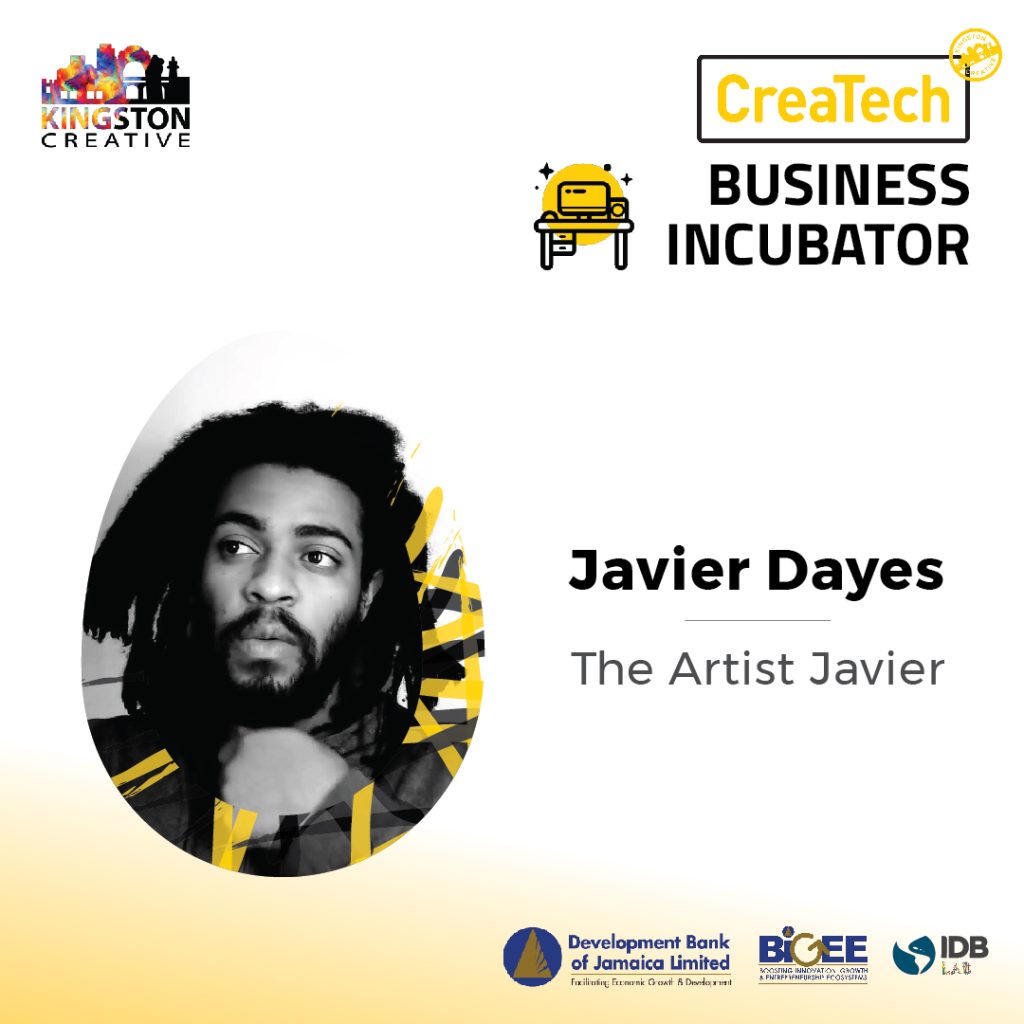
1. Javier Dayes
Javier Dayes is the multidisciplinary artist behind TheArtistJavier. Javier specialises in traditional painting, digital art, street art (including murals) and tableware! His unique style will definitely catch your attention and is an artist you should have on your radar!
Learn more about Javier here: https://theartistjavier.wixsite.com/javier
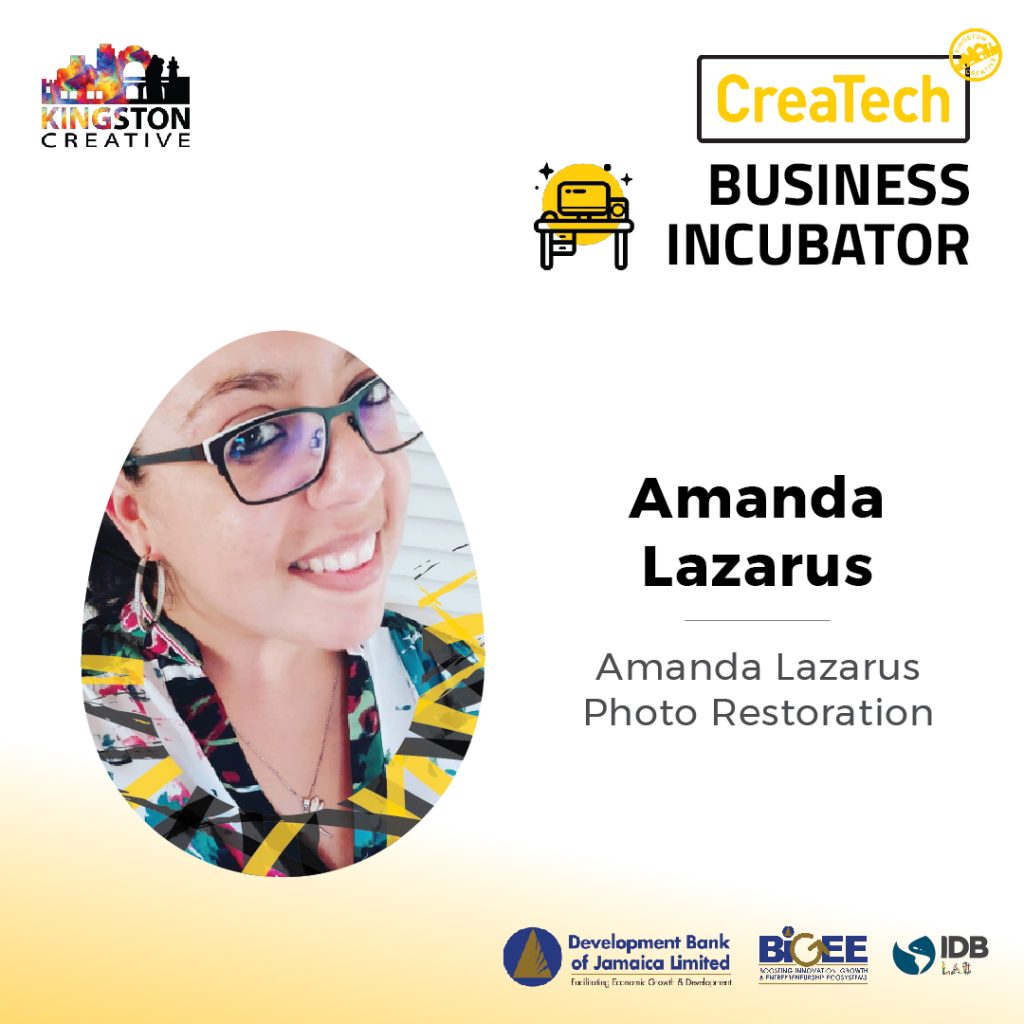
2. Amanda Lazarus
Currently employed as a Part-Time Adjunct Lecturer of Photography at Edna Manley College (SCEAP Dept.), Amanda is also working hard at developing her own niche service; Photo Restoration and Digitization. Her passion for photography expands even further as she also specialises in boudoir photography.
Her photography skills and photo restoration services are worth seeing for yourself. She is truly a talent!
Learn more about Amanda Lazarus here: https://www.linkedin.com/in/amanda-lazarus-ja/?originalSubdomain=jm
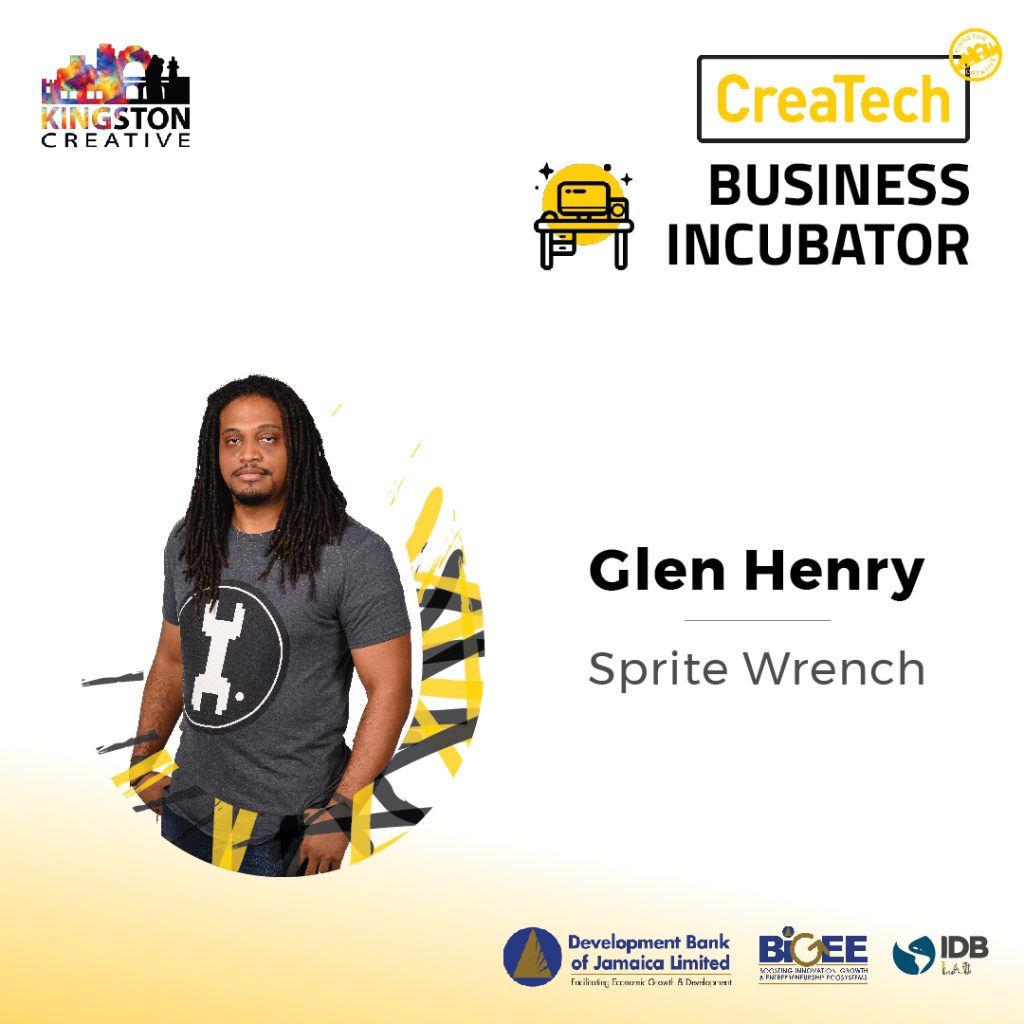
3. Glen Henry
Glen Henry is the face and fingers behind SpriteWrench Studios, an independent gaming studio that focuses on smaller, self-contained titles with an emphasis on narrative elements. He also offers consultancy services within his areas of expertise.
Learn more about SpriteWrench Studios here: https://spritewrench.com/
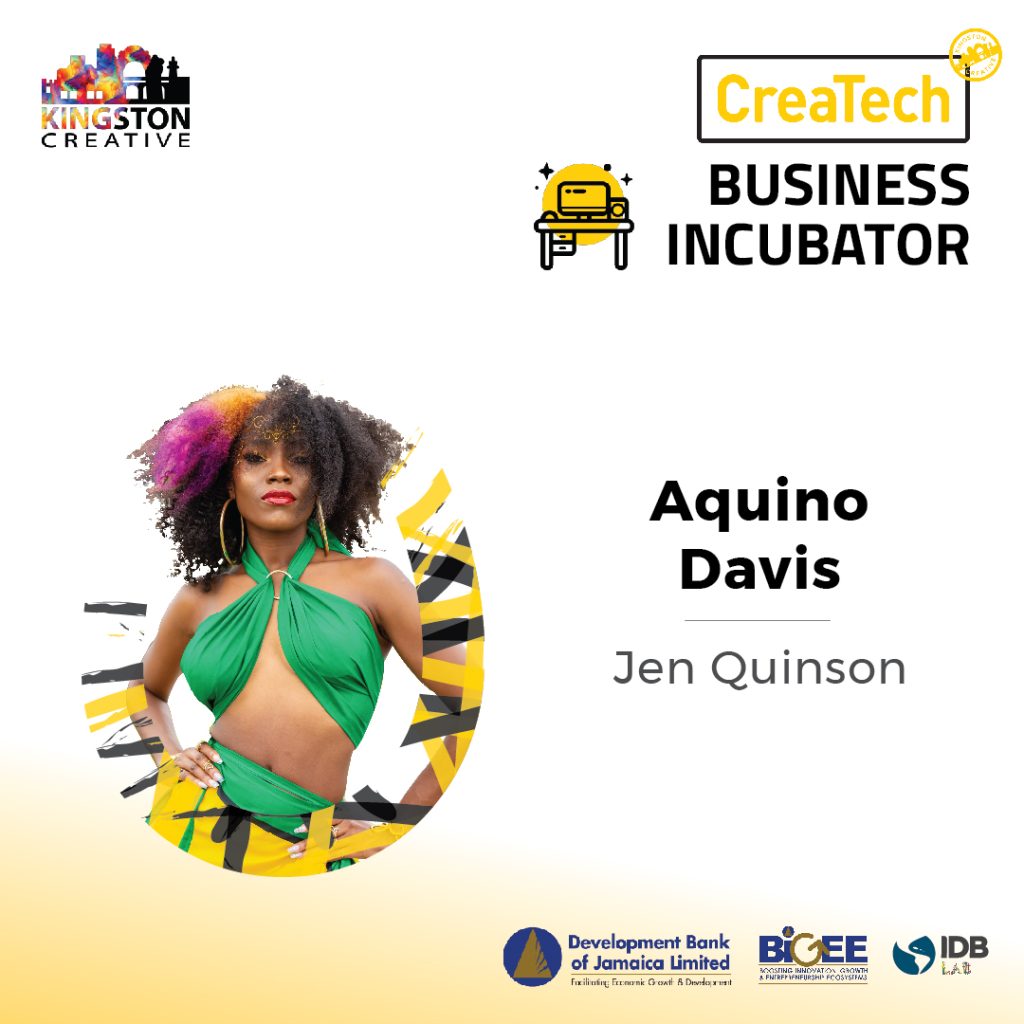
4. Aquino Davis (Rouge)
Aquino Davis, who prefers to go by the name Rogue, is the talent behind the Jen Quinson clothing brand. Specialising in beach wear, resort wear, sandals and lingerie, Rogue aspires to bring their grandmother’s dream of a clothing brand to life.
Learn more about Jen Quinson here: https://www.instagram.com/jqkingstonwest/

5. Andre Hutchinson
Andre Hutchinson is the author, designer and mind behind the Scribbles, a compelling story book series for all ages.
Learn more about Scribbles here: https://scribblespencil.com/about-us/
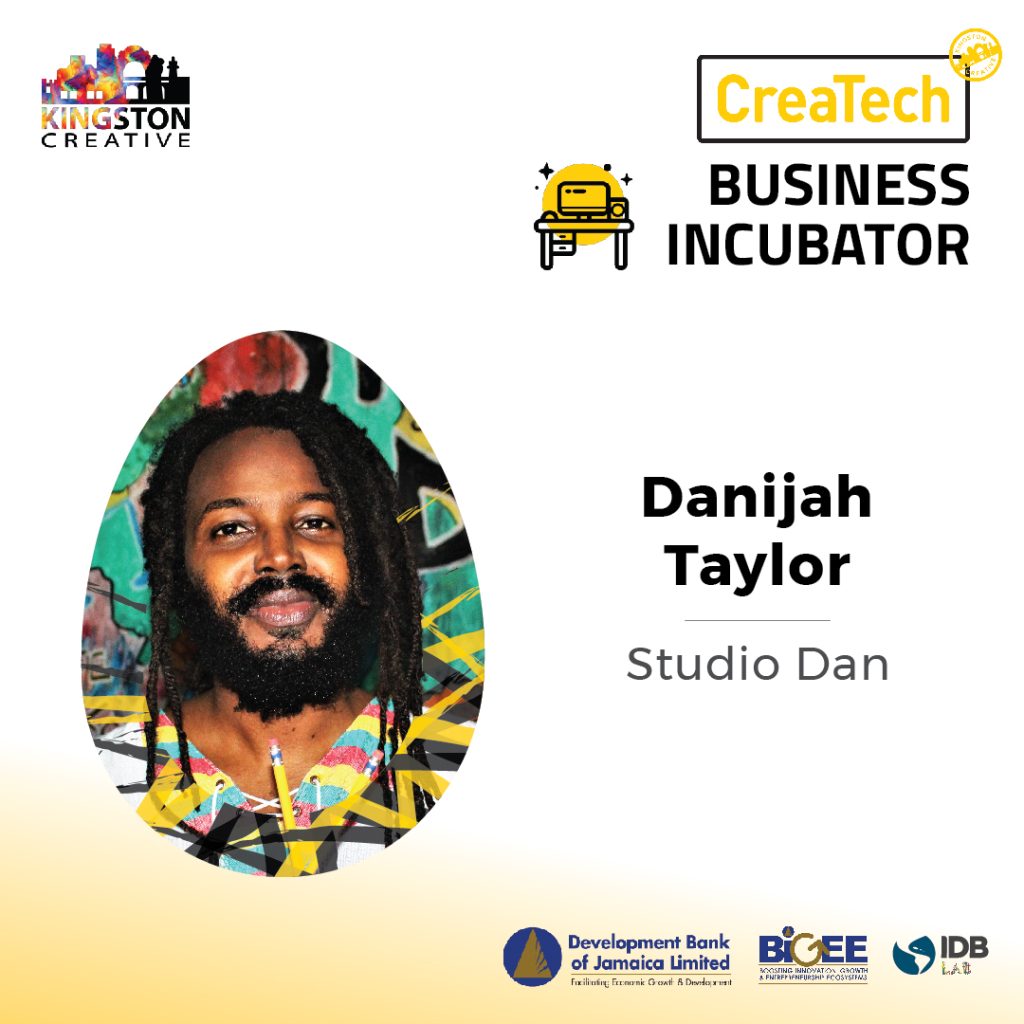
6. Danijah Taylor
Danijah Taylor is the owner of Studio Dan, a Jamaican-based production studio that focuses on “penpowerment”; the improvement of literacy, creativity, and critical thinking in our youth.
Learn more about Danijah here: https://www.instagram.com/writinggod/

7. Lisa Golding
Lisa Golding designs vibrant and uplifting stationery for ambitious women who are ready to heal, to reclaim their joy and thrive. She inspires positive thinking, joy and personal growth.
Learn more about Lisa here: https://www.behance.net/inspirespring?fbclid=IwAR1T_aHuVgbdLJRjOpd_PFkkqG3GT1FTbK-5u20sIBRIq4EeoVK1zzsV_7s
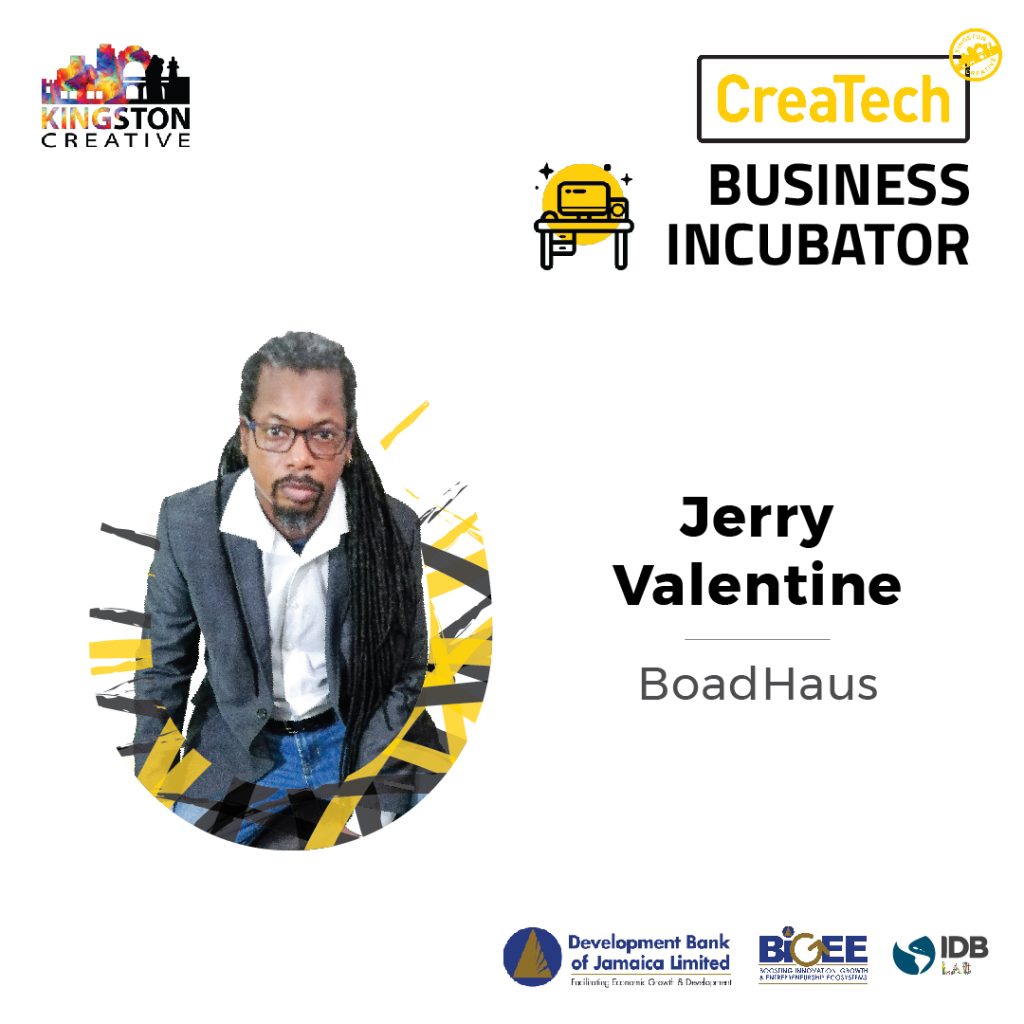
8. Jerry Valentine
Jerry Valentine is a serial entrepreneur and board enthusiast. He is owner and craftsman at BoadHaus a local woodshop that creates authentic Jamaican Woodcrafts and signs.
Learn more about BoadHaus here: https://boadhaus.com/
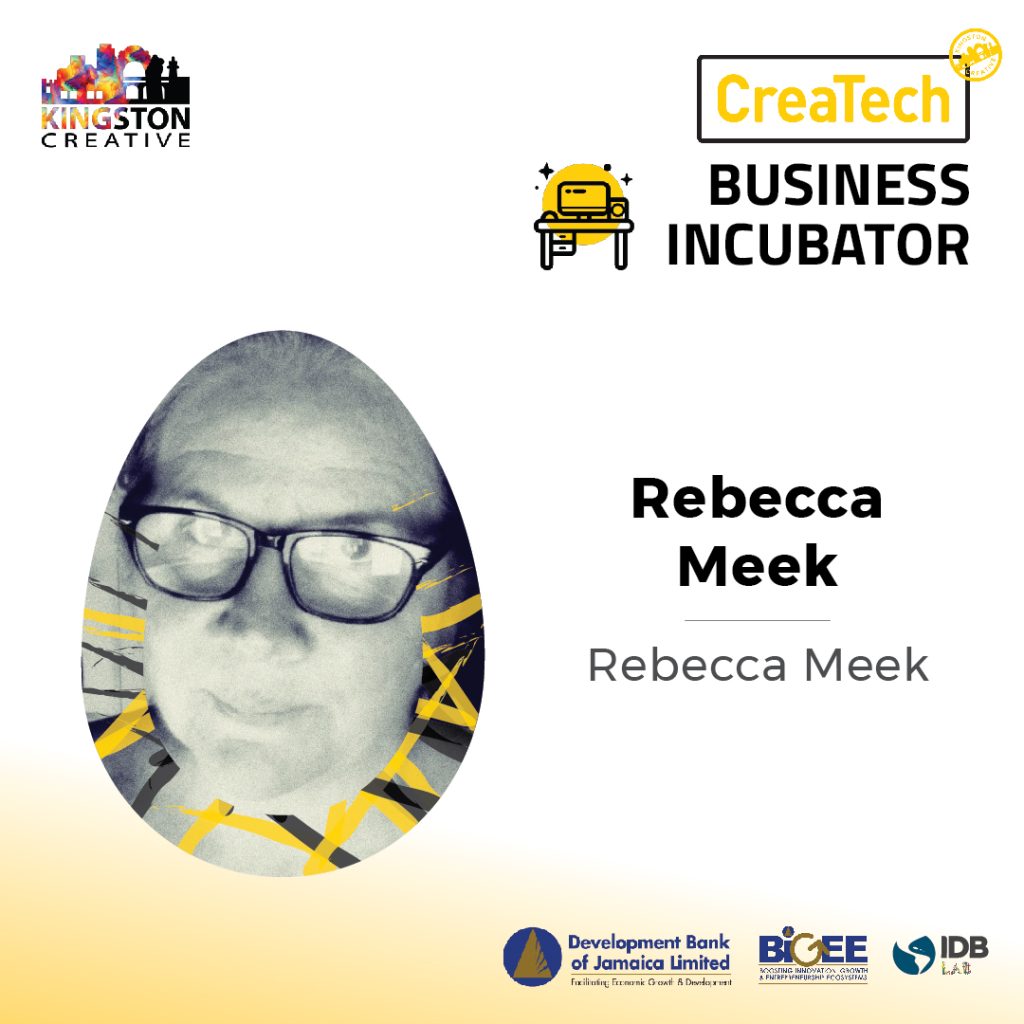
9. Rebecca Meek
Rebecca Meek is a self taught designer and photographer. She has worked with companies such as RCA, Def Jam, Philip Johnson, Island Records, Sony Music, and Deutsche Grammophon and photographed icons such as Etta James, The Isley Brothers, Run DMC, Sly & Robbie, Capleton and DJ Quik.
Learn more about Rebecca here: https://rebeccameek.com/
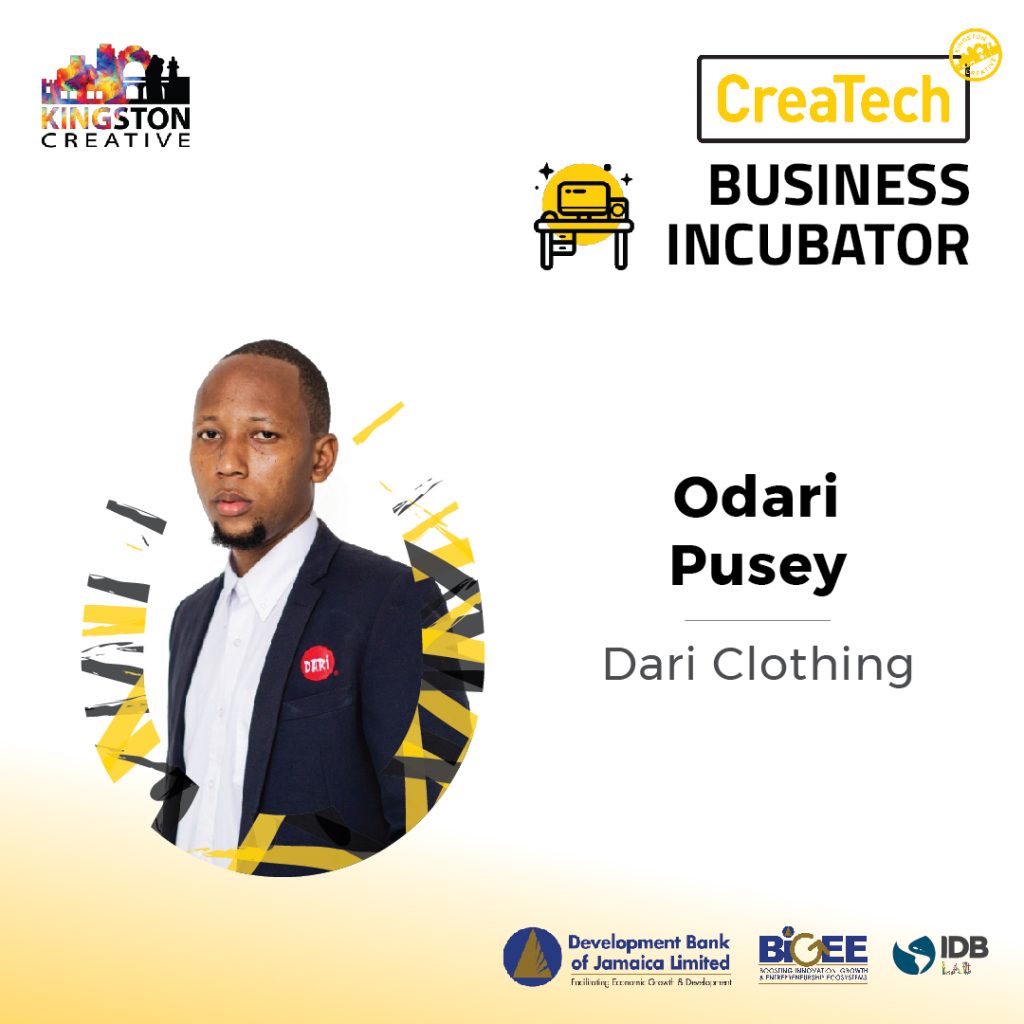
10. Odari Pusey
Odari Pusey is the CEO of DARI Clothing, a clothing company that does custom embroidery, printing and graphics based on customer requests.
Learn more about Odari Pusey here: https://www.instagram.com/dari_clothing/
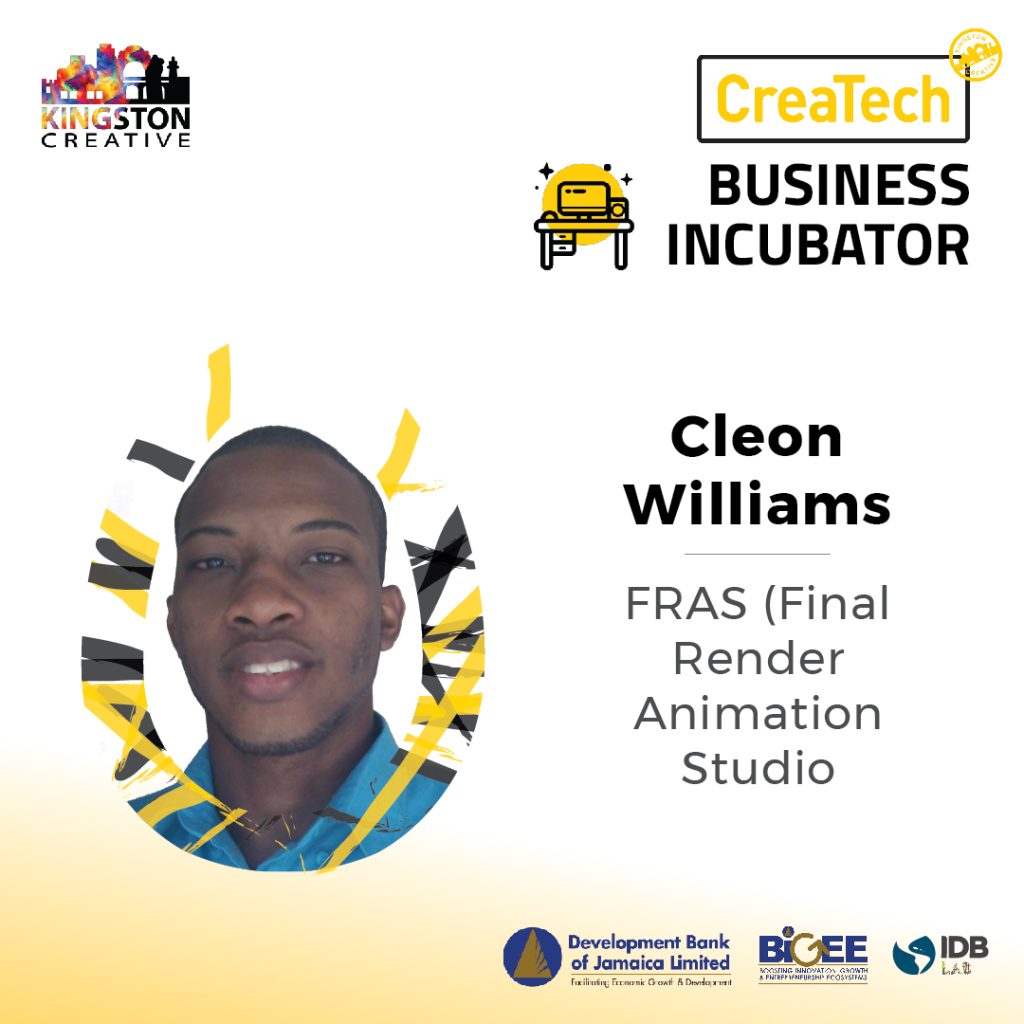
11. Cleon Williams
Cleon Williams is the founder of Final Render Animation Studio (F.R.A.S), an independent studio that creates immersive and dynamic content for global consumption and engagement within the animation and game development society.
Learn more about Final Render Animation Studio: https://cleowillo.itch.io/
12. Khadijah Hurst
Khadijah Hurst is the mind behind MoBay Link, a company that aims to become a thriving network of and for Entrepreneurs: to support and scaffold solid bases from which to thrive and promote their products, services, businesses, brands, and personalities both island-side and beyond Jamaicas shores.
Learn more about Khadijah here: https://www.facebook.com/MoBayLink/
The Creative Hub Incubator is one of several initiatives under the Kingston Creative CREATECH programme, a partnership with IDB Lab designed to provide opportunities for creative entrepreneurs. To learn more about CREATECH visit: https://kingstoncreative.org/createch/.
Meet the Go Global Accelerator Awardees!
Hey KC Fam! Hope you are doing great this Friday! This Friday, we are excited to introduce you to the awardees for our Go Global Accelerator Programme, one of the several programmes done under the CreaTech initiative, done in partnership with IDB Labs and the Development Bank of Jamaica!
In the Accelerator, 10 creative entrepreneurs were accepted as our first cohort. For 3 months, these creative entrepreneurs did courses to help improve:
- Their business skills
- Their technology skills
- Their ability to tap into global markets.
We are proud of the progress these entrepreneurs have made in the Go Global Accelerator and are excited to share these creative entrepreneurs with you!
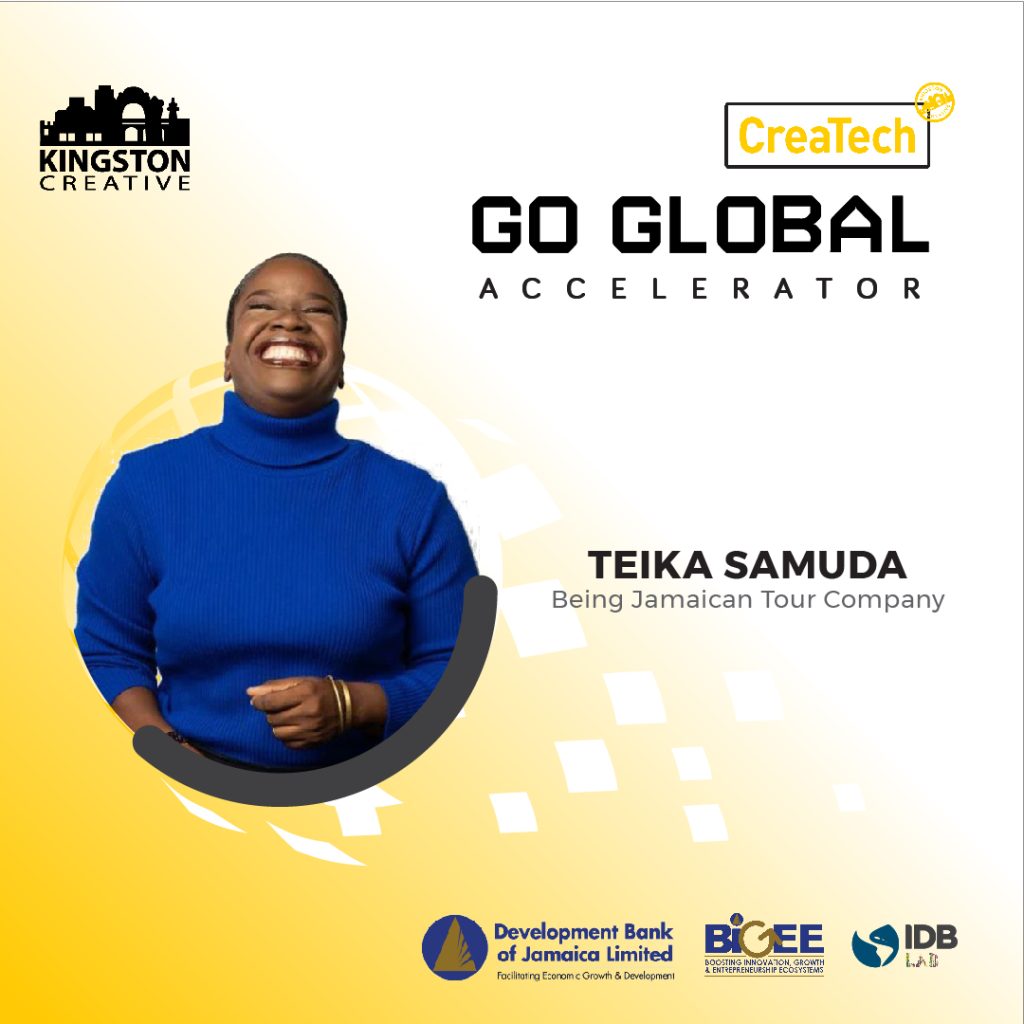
1. Teika Samuda
Teika Samuda is the principal consultant at the Being Jamaican Tour Company. Being Jamaican offers authentic Jamaican experiences and curates packages that feature the best of Jamaica; highlighting its people, culture, music and natural beauty. Being Jamaican removes the hassles of planning and executing a trip, allowing clients to focus on enjoying the experience.
Follow Teika here: https://www.instagram.com/teikasamuda
And book your first Being Jamaican tour here: https://www.instagram.com/beingjamaican
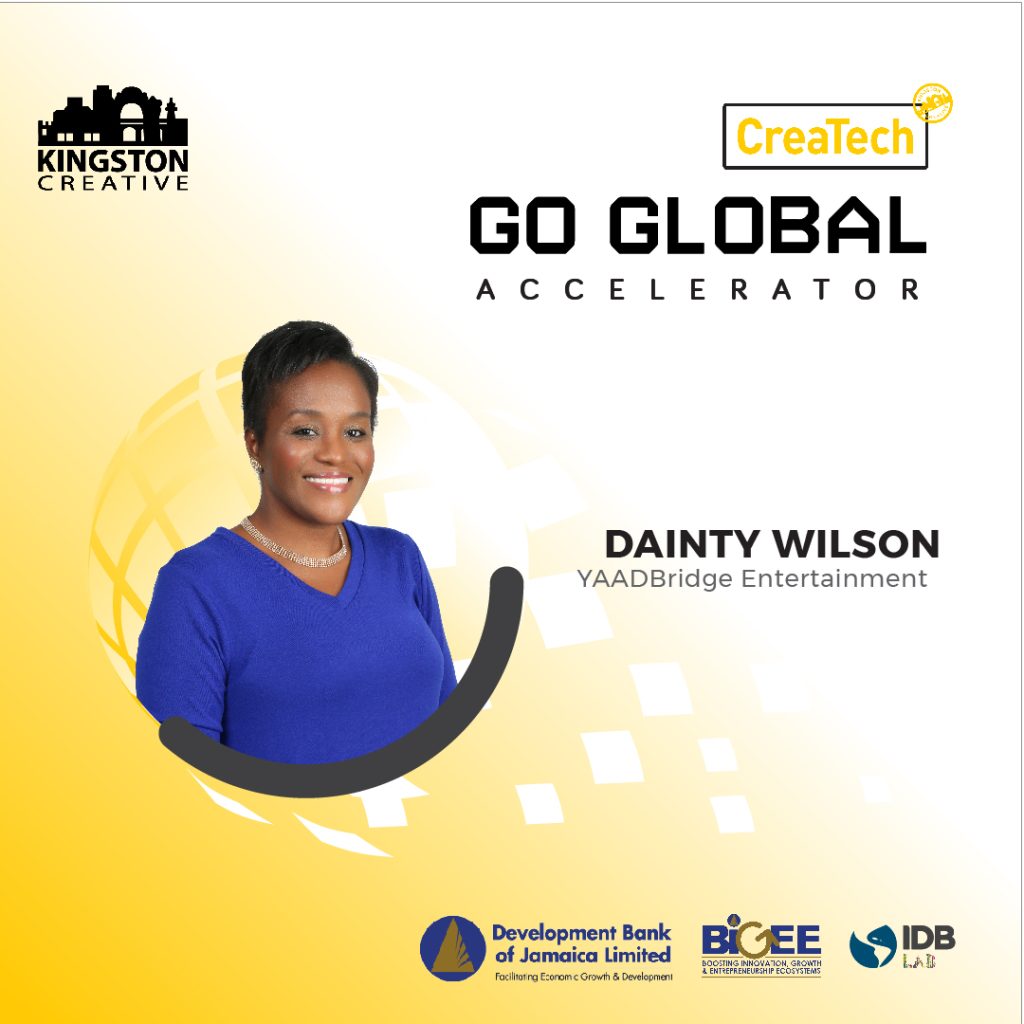
2. Dainty Wilson
Dainty Wilson is the Managing Director of YAADBridge Entertainment, a film, television and audio production Company with a focus on creative production, audio-visual entertainment and talent management in the Caribbean.
Follow Dainty WIlson here: [link to personal page: https://instagram.com/daintyfaces
Learn more about YAADBridge here: https://yaadbridge.com
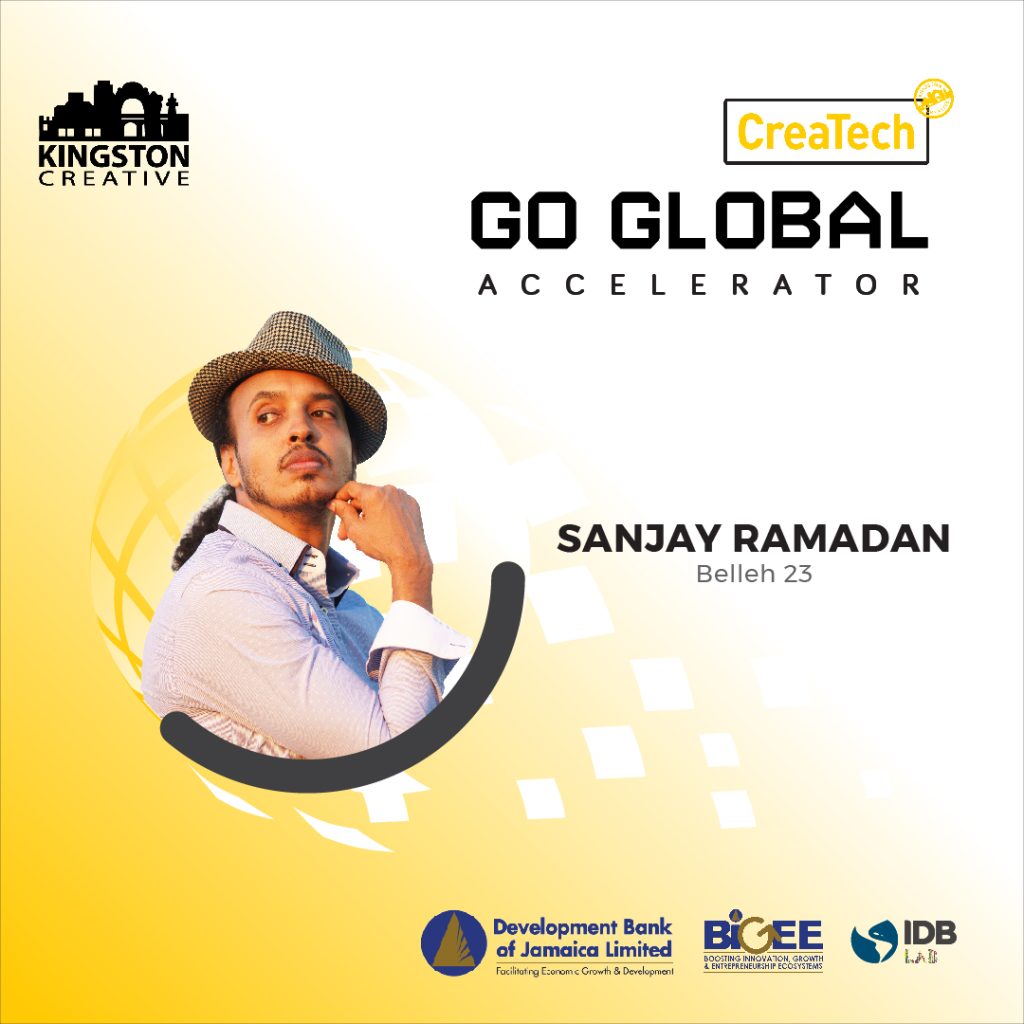
3. Sanjay Ramadan
You may know Sanjay as one of the hosts of the TVJ programme Intense, but in our Go Global Accelerator programme, he is the CEO of BELLEH23, a company that provides creative lodgings for International travelers with a core demographic of Dancehall Dancers internationally.
Learn more about BELLEH23 here: http://www.belleh23ja.com
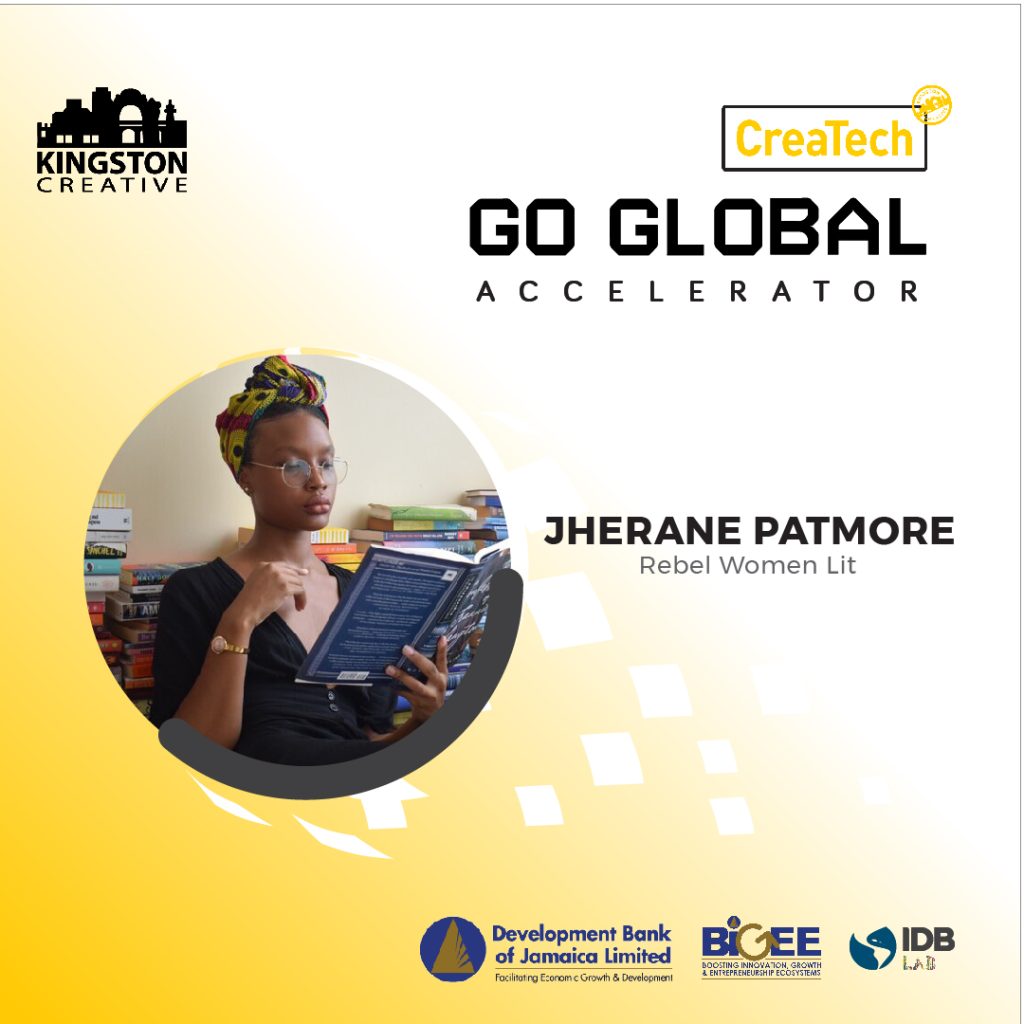
4. Jherane Patmore
Jherane Patmore is the founder of Rebel Women Lit (RWL), a community of literary community-based in Jamaica, with members worldwide interested in using literature as a source of self-care. RWL has paid membership, an e-commerce bookstore, a podcast, and an active newsletter.
Learn more about Rebel Women Lit here: https://www.rebelwomenlit.com
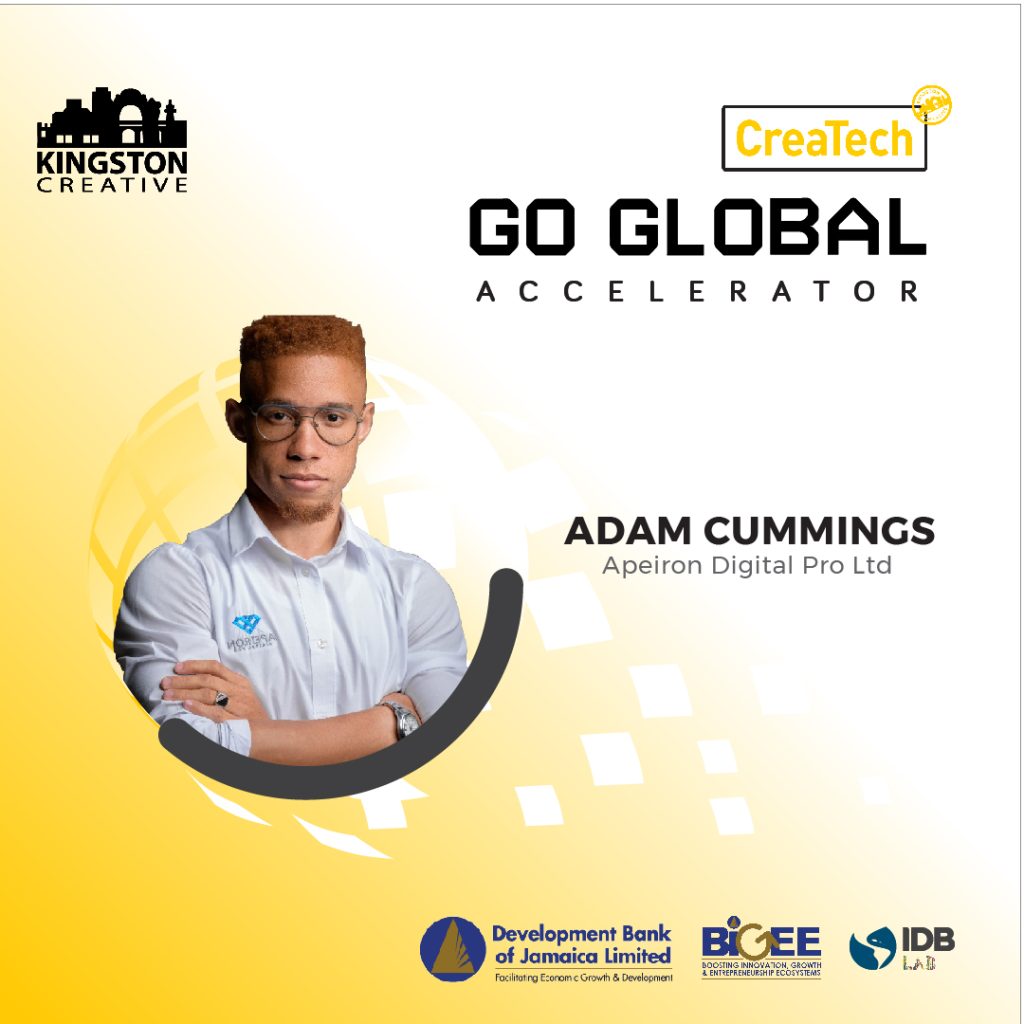
5. Adam Cummings
Adam Cummings is the CEO of Apeiron Digital Pro Ltd, is a creative digital media company that creates compelling visual content through photography, videography, digital cinematography and graphic design. They combine creative storytelling techniques with high quality visuals to move audiences and supply clients with what they need for their consumers.
Learn more about Apeiron Digital Pro Ltd here: https://www.instagram.com/apeiron.dp
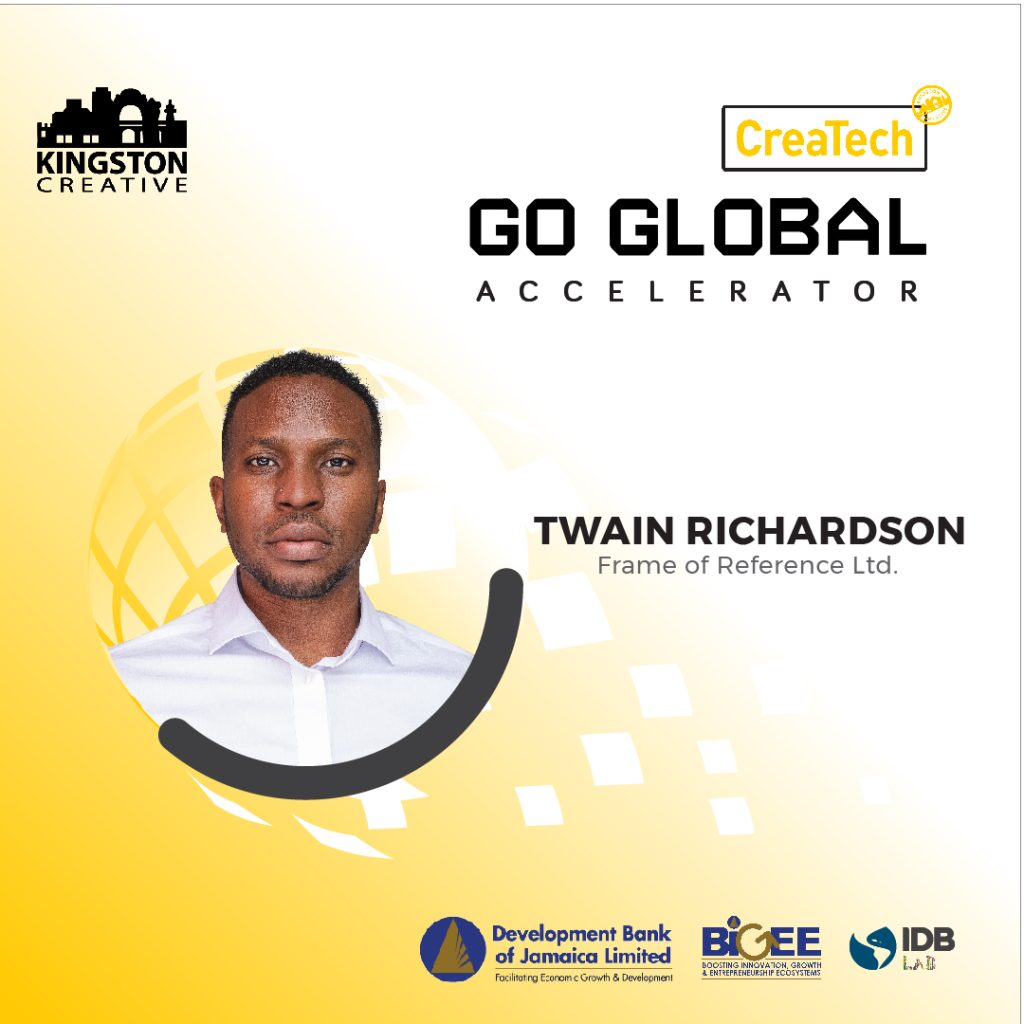
6. Twain Richardson
Twain Richardson is the Colourist/ Finishing Editor at Frame of Reference Ltd (FoR), the leading post production studio in Jamaica. FoR is renowned for delivering exceptional video editing, colour grading, vfx, and motion graphics services to their clients and has developed an identity that provides reliability, efficiency and quality in all our services.
Follow Twain Richardson here: [link to IG: https://www.instagram.com/twainrichardson
Learn more about Frame of Reference here: https://www.facebook.com/forpostprod
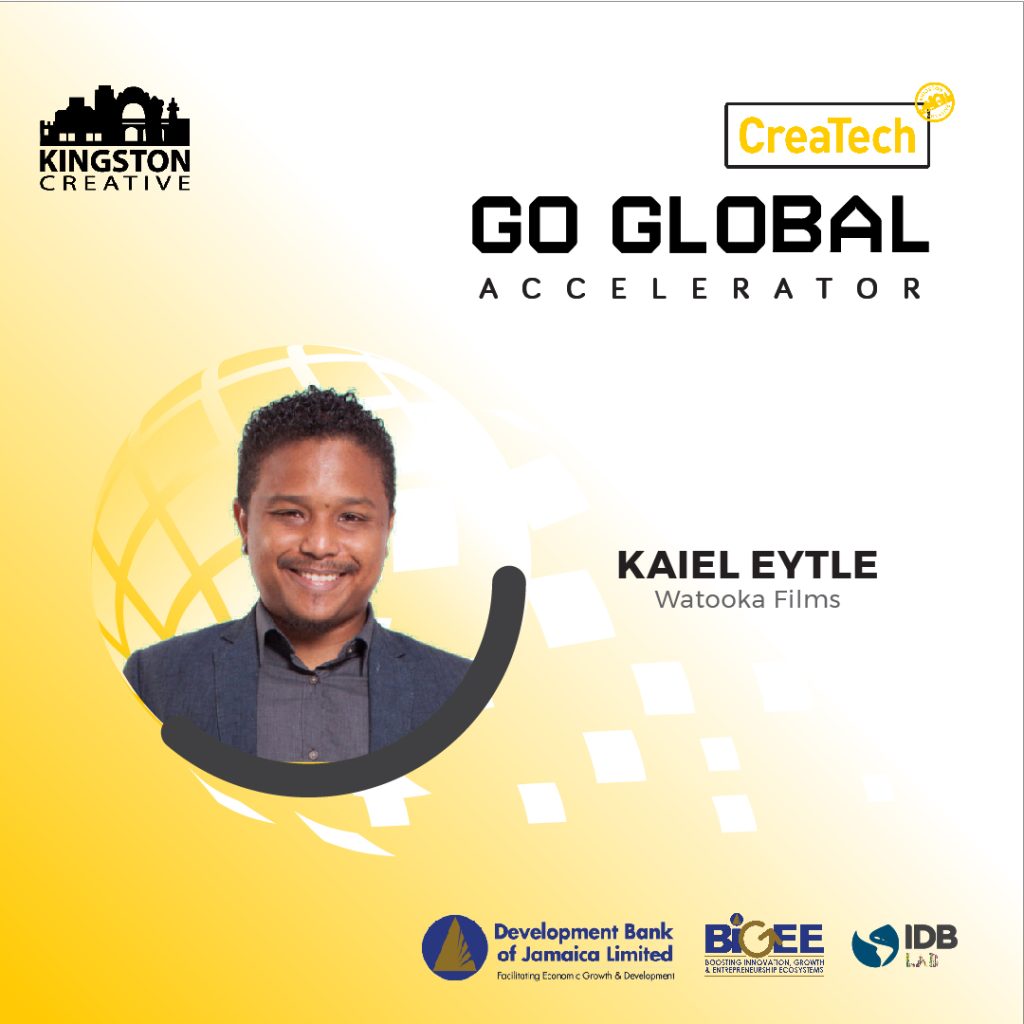
7. Kaiel Eytle
Kaiel Eytle is the CEO of Watooka Films Ltd, a company focused on developing original content for the screen. Taking IP from source material or IP stage right through both creative and business development stages to pair it with producers and distributors worldwide.
Learn more about Kaiel here: https://www.linkedin.com/in/kaielaeytle/?originalSubdomain=jm#experience
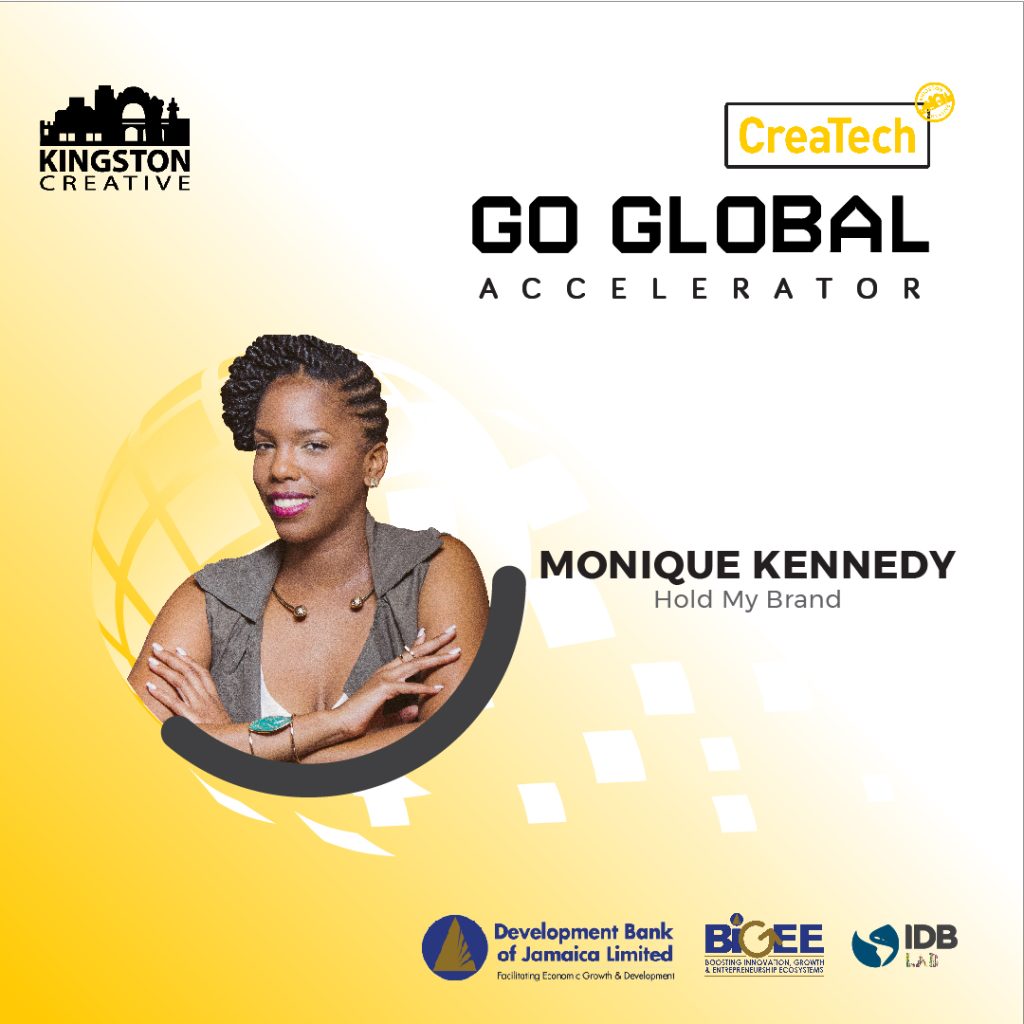
8. Monique Kennedy
Monique Kennedy is the CEO of Hold My Brand (HMB), a company that delivers on-demand branding services to start-ups and small businesses. Their clients (entrepreneurs in the U.S. and Canada) gain access to the expertise and support of a full branding team of qualified designers from Jamaica and the Caribbean, for the cost of hiring one (1) freelancer in North America and 60% less than hiring a traditional agency.
The cornerstone of our operations is our project management framework that has allows us to cut the average delivery timeline of 6-12 weeks down to as little as one (1) day.
Learn more about Monique and Hold My Brand here: https://www.linkedin.com/in/shesmonique/?originalSubdomain=jm
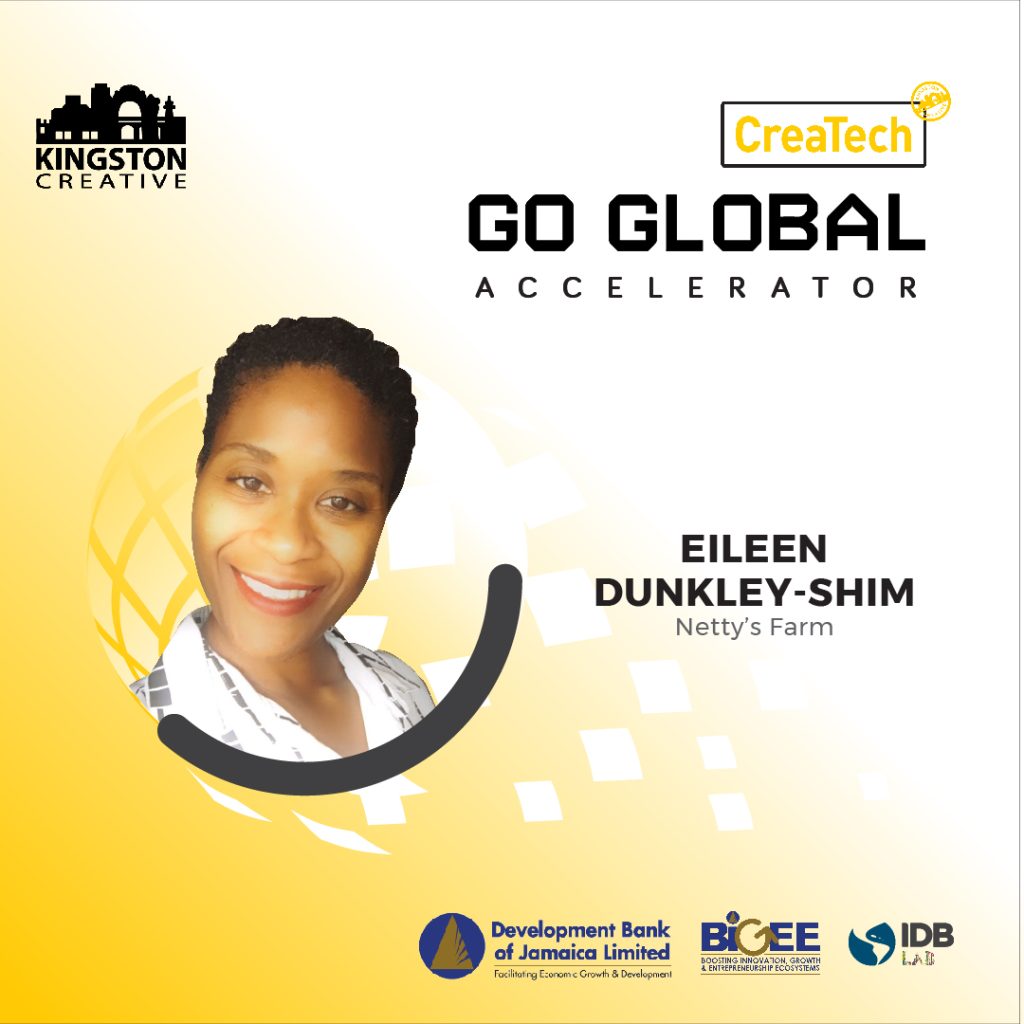
9. Eileen Dunkley-Shim
If Eileen Dunkley-Shim seems familiar to you, that’s because on top of being a part of our Accelerator, she was the second place winner in our Best Pitch Forward Competition last year!
Eileen’s Netty’s Farm brand sells kombucha and strives to be Jamaica’s number 1 kombucha brand. Kombucha is a fermented fizzy tea, flavoured with fruits and spices. As of right now, Netty’s Farm kombucha now retails in 4 locations in Kingston and 1 cafe in Montego Bay.
Learn more about Netty’s Farm here: https://www.instagram.com/nettysfarm

10. Alison Hinds
Alison Hinds is the brain behind AliCraftsJa, an art education operation that usually hosts Paint N Sip events. However they do occasional sales from selling artwork such as quote boards, paintings and pop-up cards.
Learn more about AliCraftsJa here: https://www.facebook.com/AlicraftsJa
The Go Global Accelerator is one of several initiatives under the Kingston Creative CREATECH programme, a partnership with IDB Lab designed to provide opportunities for creative entrepreneurs. To learn more about CREATECH visit: https://kingstoncreative.org/createch/.
Naomi: Avec Amour – Shekinah Ade-Gold
“Naomi: Avec Amour”
The most that I’ve done during my short time in the creative circle has primarily been my involvement in the areas of music and drama. I’ve had passing interests in photography, painting, animation, and even dancing. But fashion? I rarely ever considered it. I don’t even consider myself to be a fashionable type – I pretty much just go out in whatever I throw on. Even when I perform, I’ve realized that if a dress code isn’t provided, I’ll just turn up in whatever caught my eye as “comfortable” (given that the women in the house didn’t tell me to take it off first). So for the Kingston Creative Online Open Commission, and for my first time since honing the craft of blogging in the arts-therapy niche (musicandpain.com), I decided to look at what exactly a fashion designer does. Do they eat? Sleep? I had to know.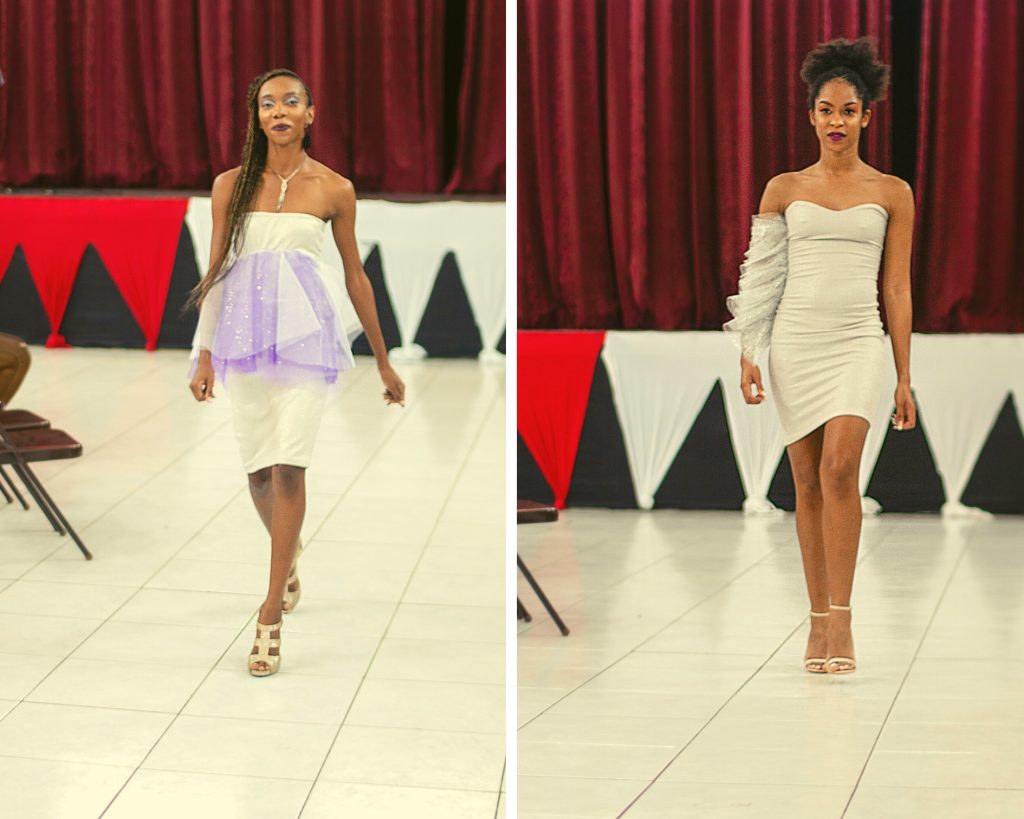
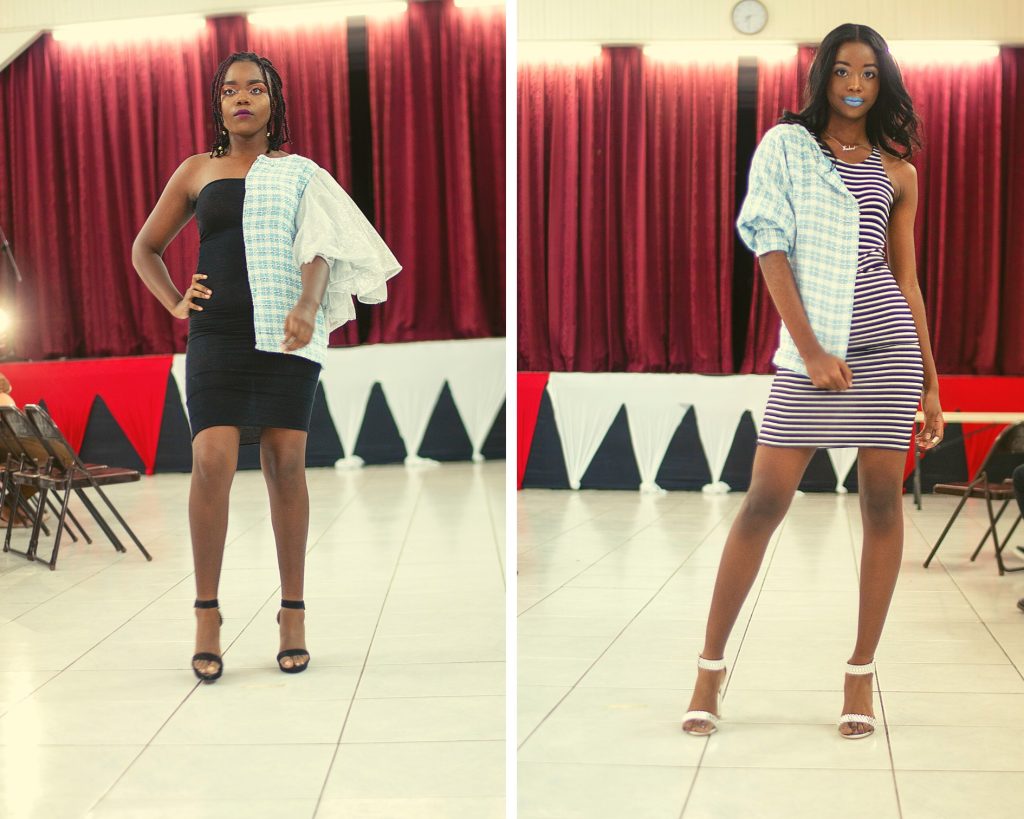
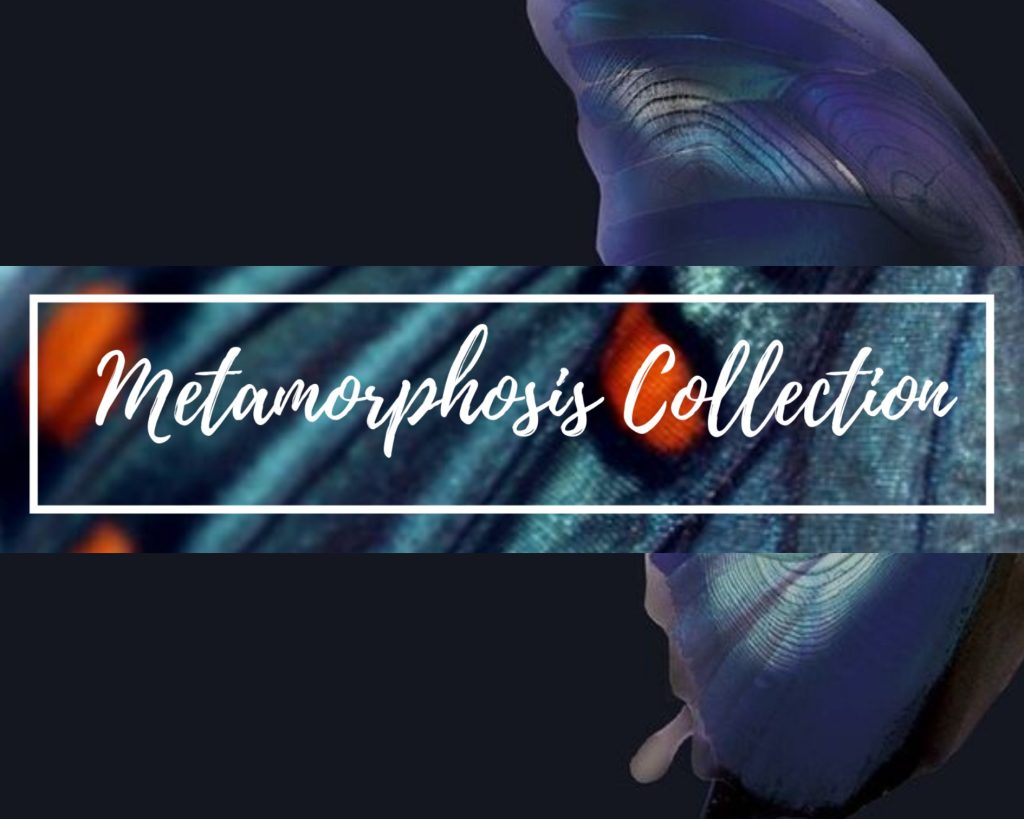
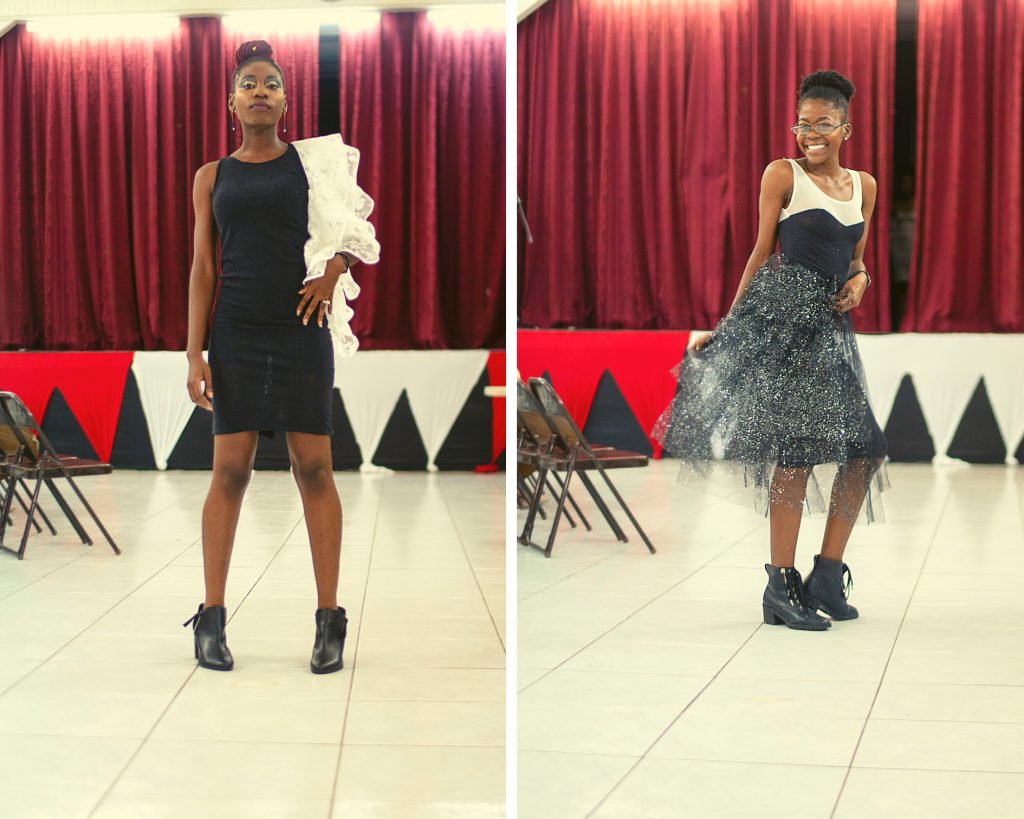
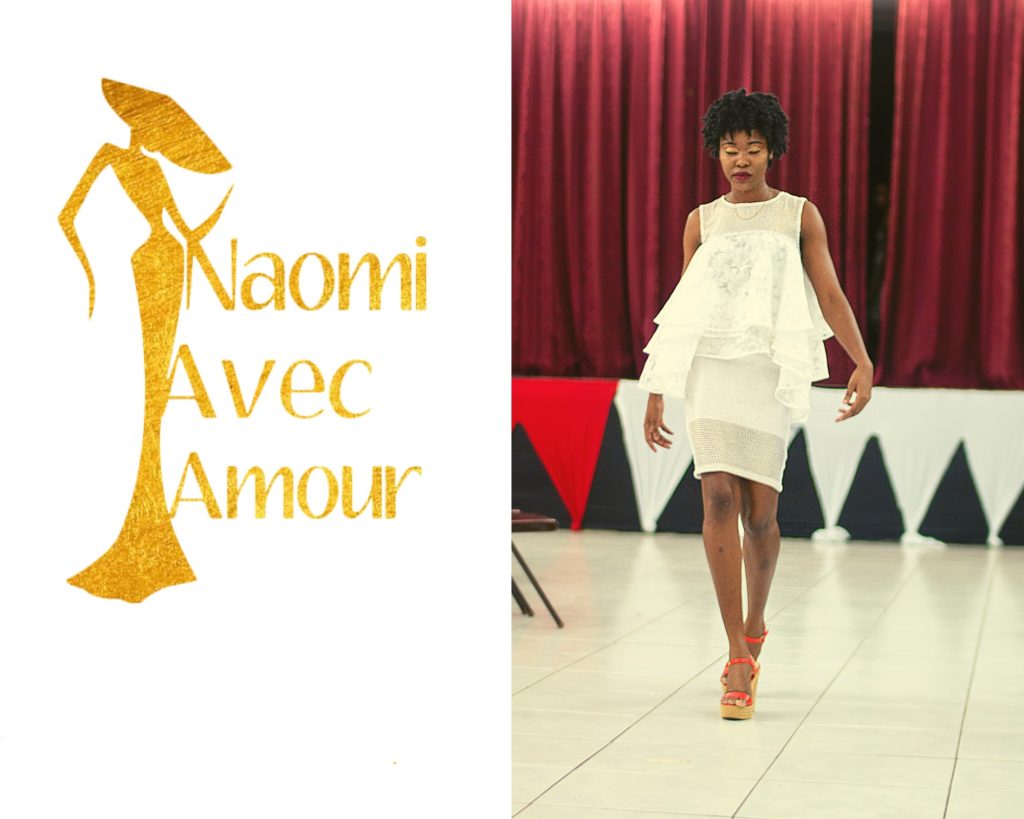
NMIA Monument Art Project
The operators of the Norman Manley International Airport (NMIA) have announced an open call for the Kingston Airport Roundabout Art Monument Project that will transform the recently renovated roundabout into a cultural landmark.
The open call invites Jamaican artists, who are citizens and residents currently living in Jamaica, to create an iconic mural that will welcome visitors to Kingston and leave a lasting impression on departing travellers.
